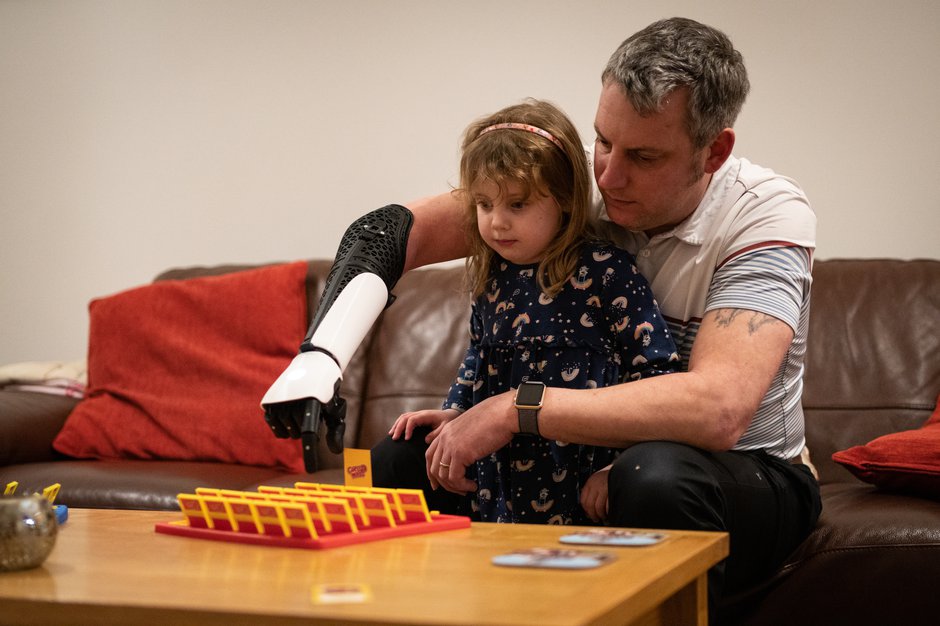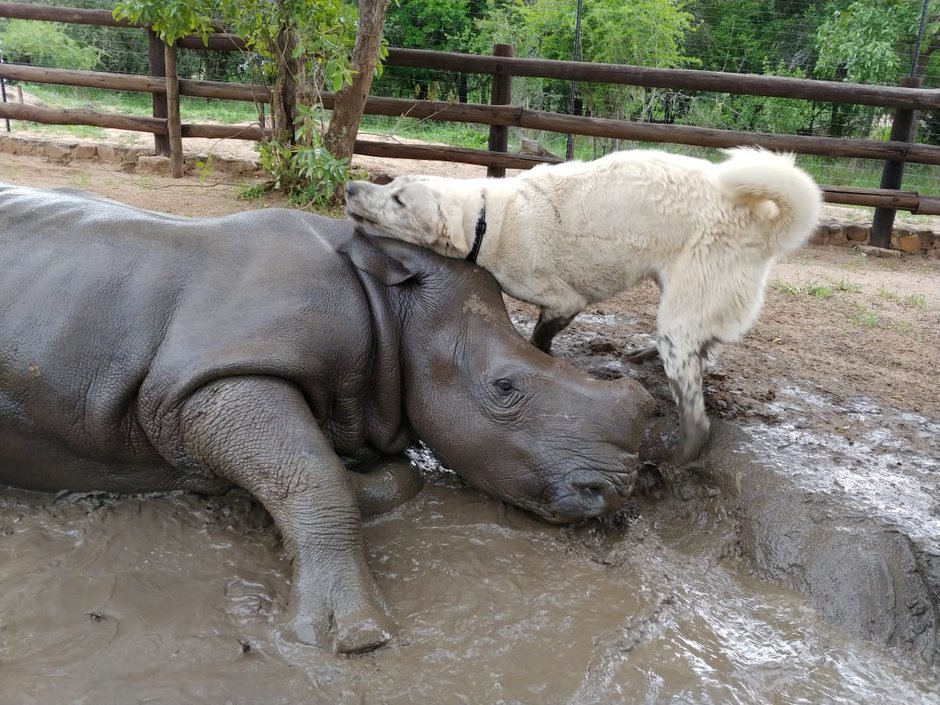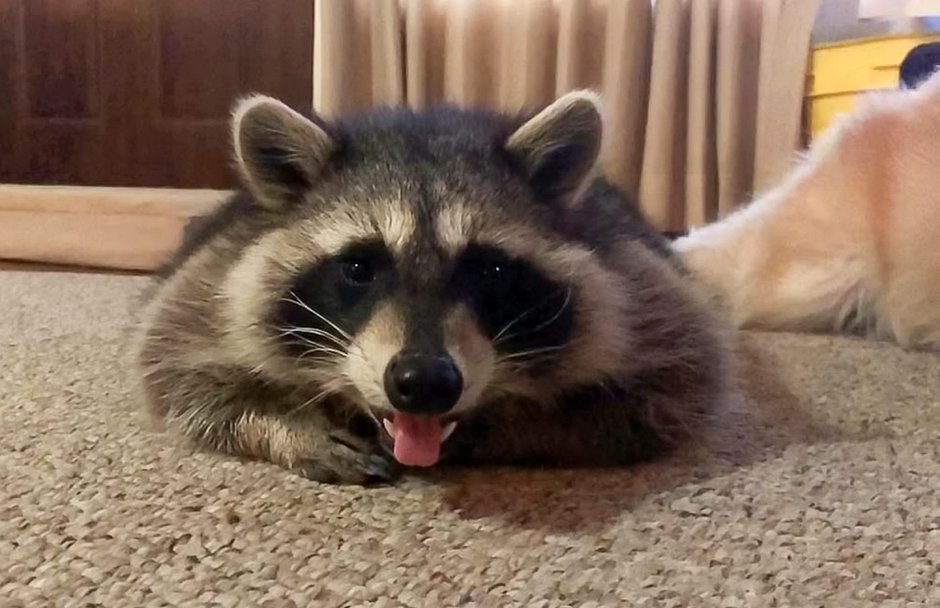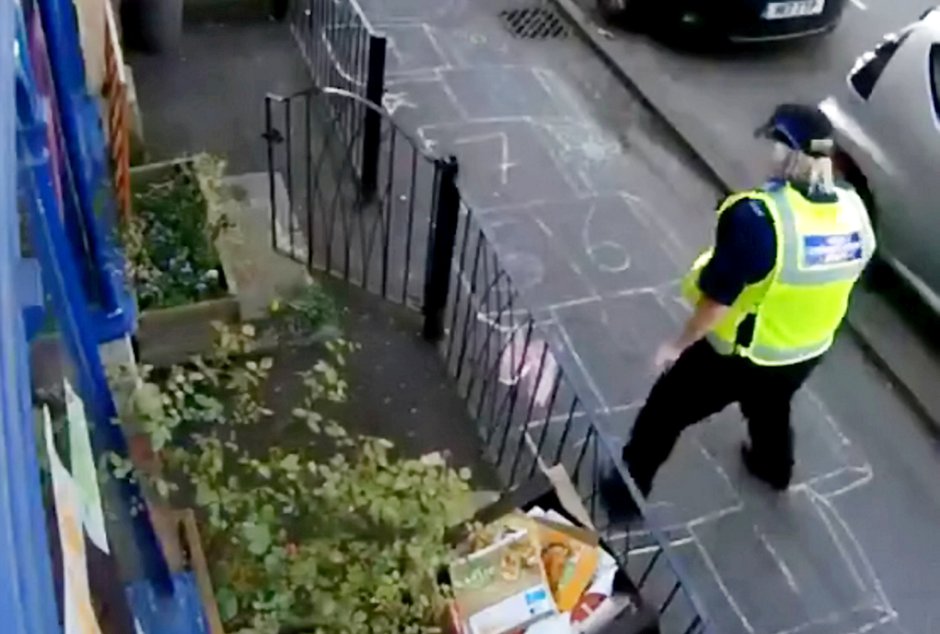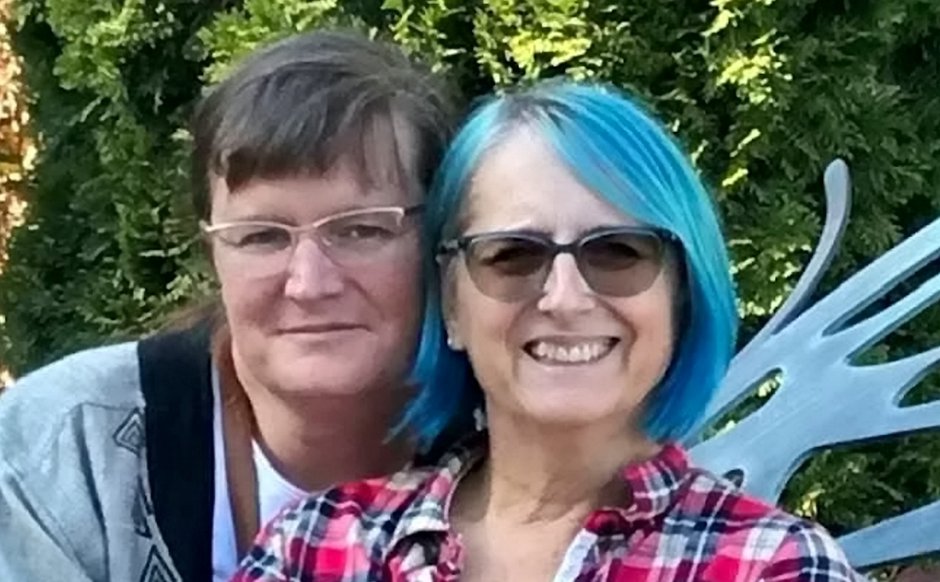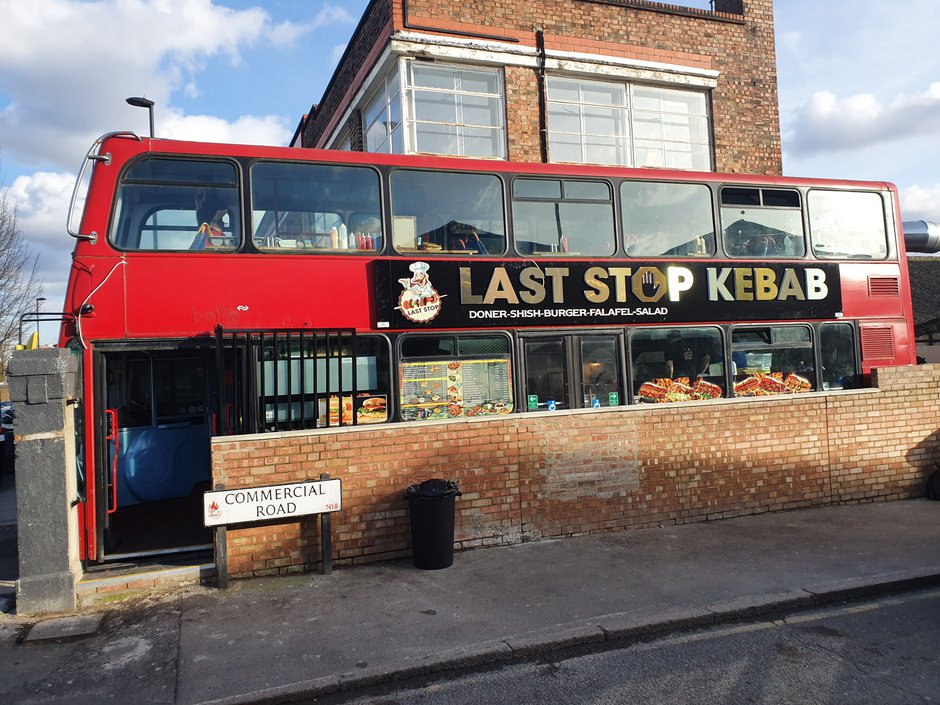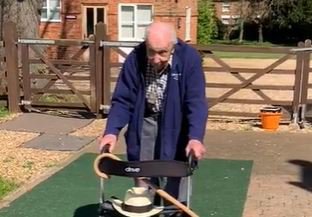Dad-of-two who lost arm while serving in Afghanistan becomes first military veteran in the world to receive a 3D-printed multi-grip 'bionic arm'
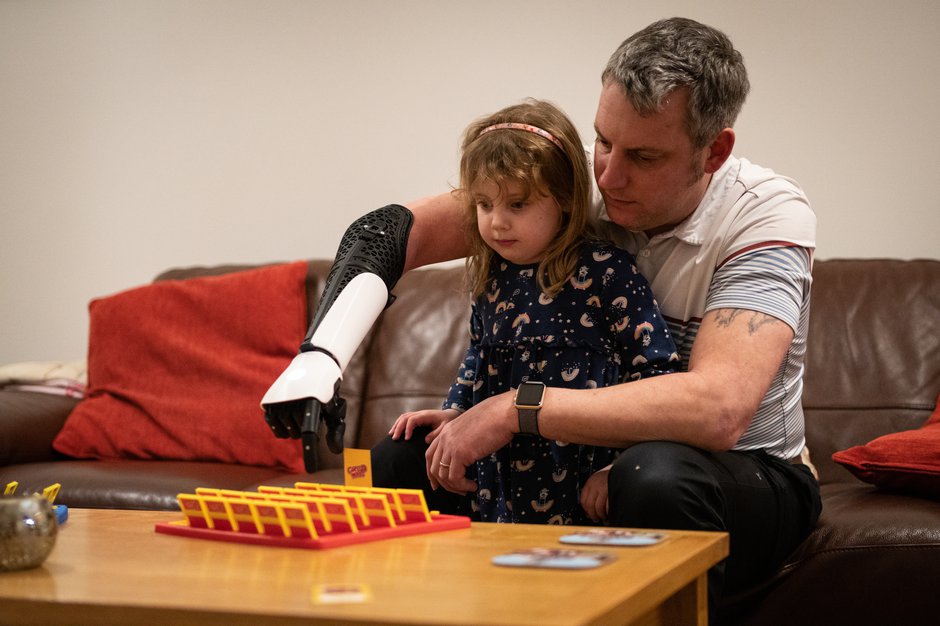 Image by: Simon Galloway
Image by: Simon Galloway
A British army veteran who lost an arm while serving in Afghanistan has become the first serviceman in the world to receive a 3D-printed multi-grip 'Hero Arm'.
Darren 'Daz' Fuller lost his right hand and forearm a decade ago when a friendly mortar in Helmand Province inexplicably misfired and struck him.
The 43-year-old says recovering from the trauma was "immensely difficult" but that he is experiencing a "new lease of life" after being fitted with the "incredible" bionic arm.
The prosthetic, which Bristol-based firm Open Bionics market as the 'Hero Arm', is made using a state-of-the-art 3D printer and gives amputees never before experienced dexterity.
The bionic arm works by picking up signals from muscles in the user's residual limb.
When Daz flexes his muscles, special sensors detect naturally generated electric signals and convert these into intuitive and proportional hand movements.
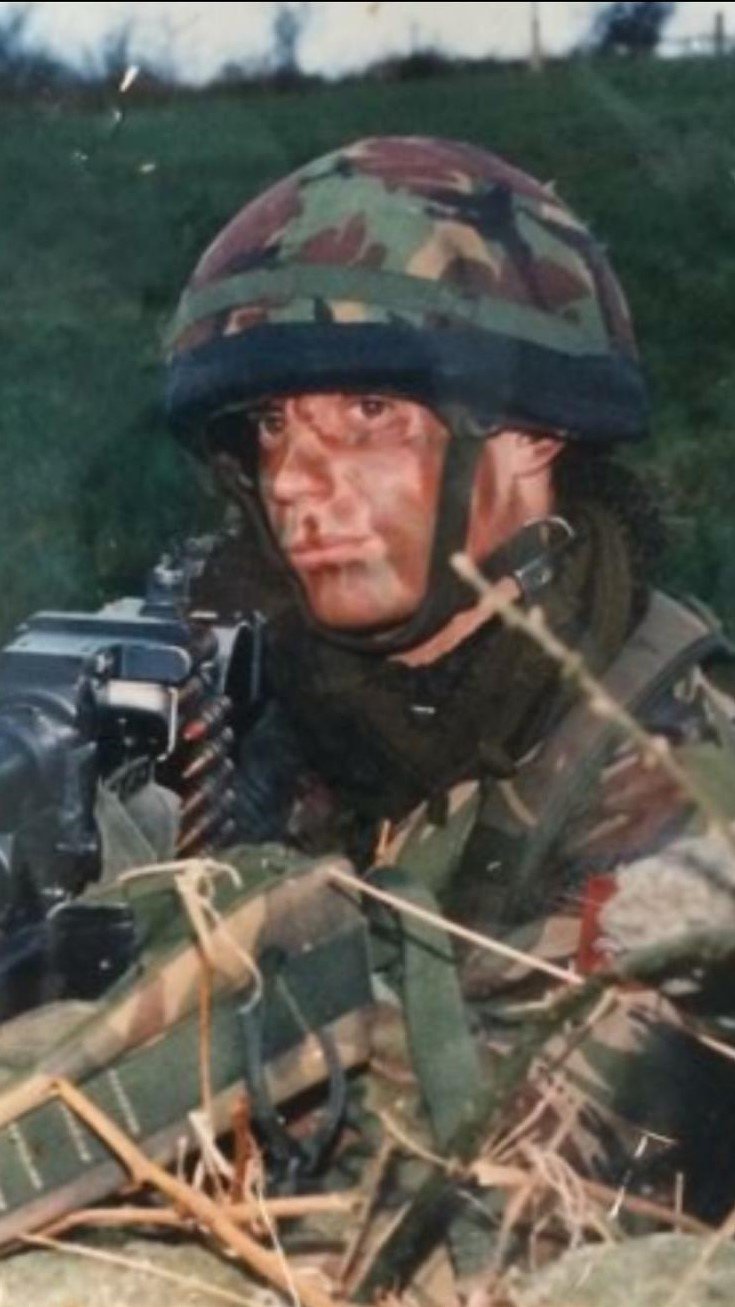 Image by: Simon Galloway
Image by: Simon Galloway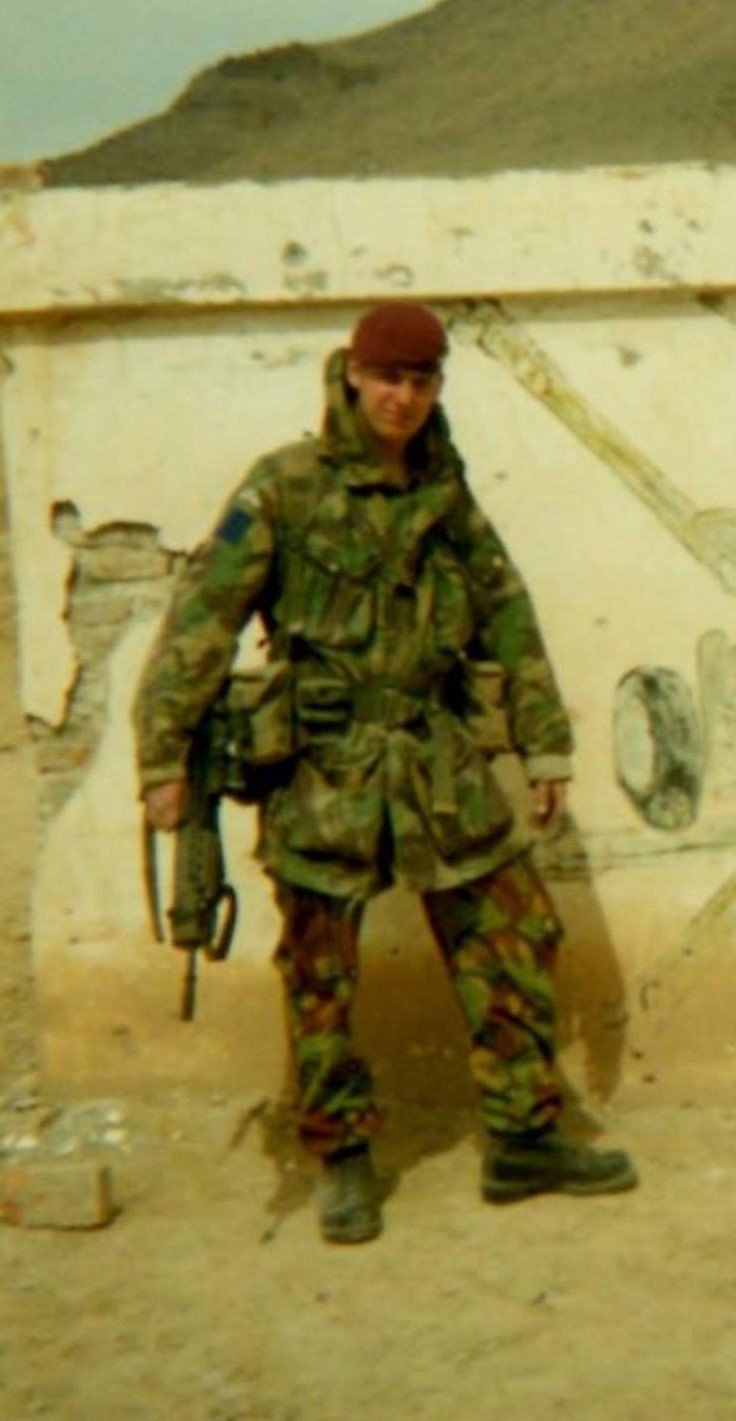 Image by: Simon Galloway
Image by: Simon Galloway
Since receiving his arm, Daz has been able to hold his daughter's hand with his right hand for the first time ever and use a knife and fork, which he hasn't been able to do for years.
He said: "I can now do so many of the little things that most people take for granted - I'm so happy.
"I can hug my daughter and play games with her in a way I have never been able to before, it's amazing.
"There are so many things I’m doing two handed compared to before, and so many things I'm still discovering.
"It's a really exciting time."
Daz, who lives in Colchester, Essex, with his wife and four-year-old daughter Sky, enlisted into the Parachute Regiment in 1994 and served for 20 years.
He completed tours in Northern Ireland, Macedonia and Iraq before his fateful final outing in Afghanistan in 2008, when his right hand and forearm were blown clean off.
The section commander was operating army weaponry to provide support for troops patrolling nearby when an explosive shell, or mortar bomb, went off and struck him.
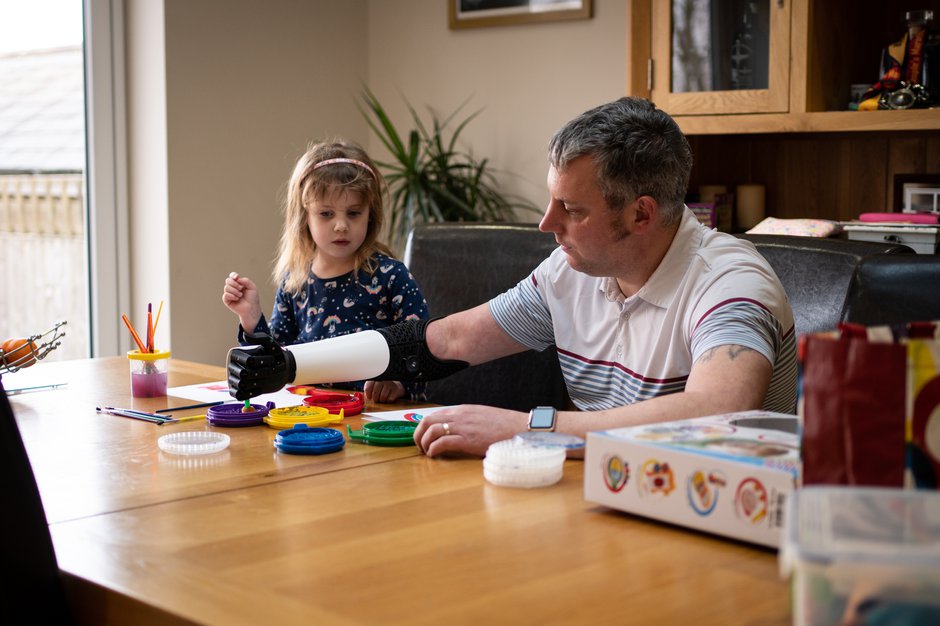 Image by: Simon Galloway
Image by: Simon Galloway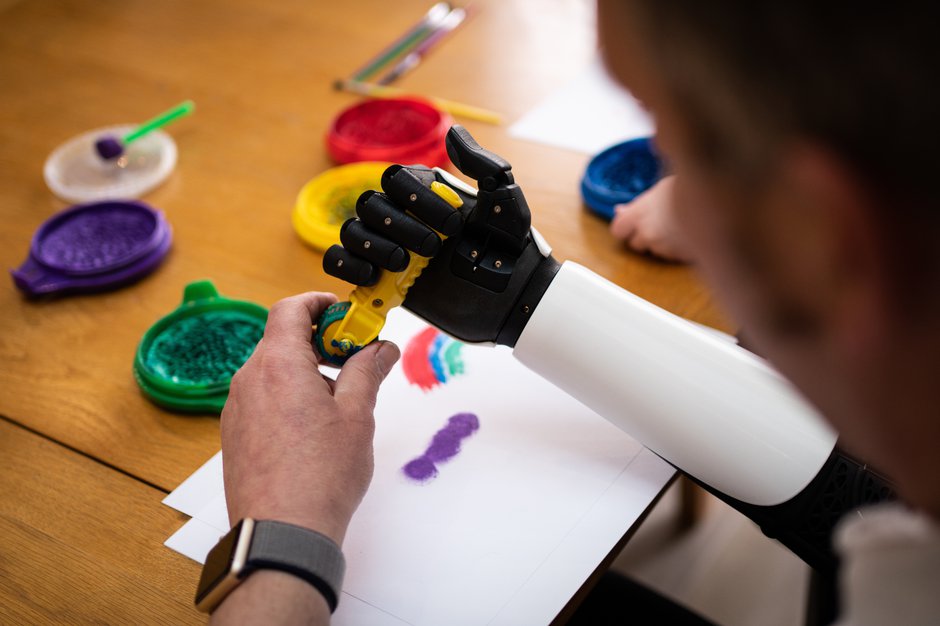 Image by: Simon Galloway
Image by: Simon Galloway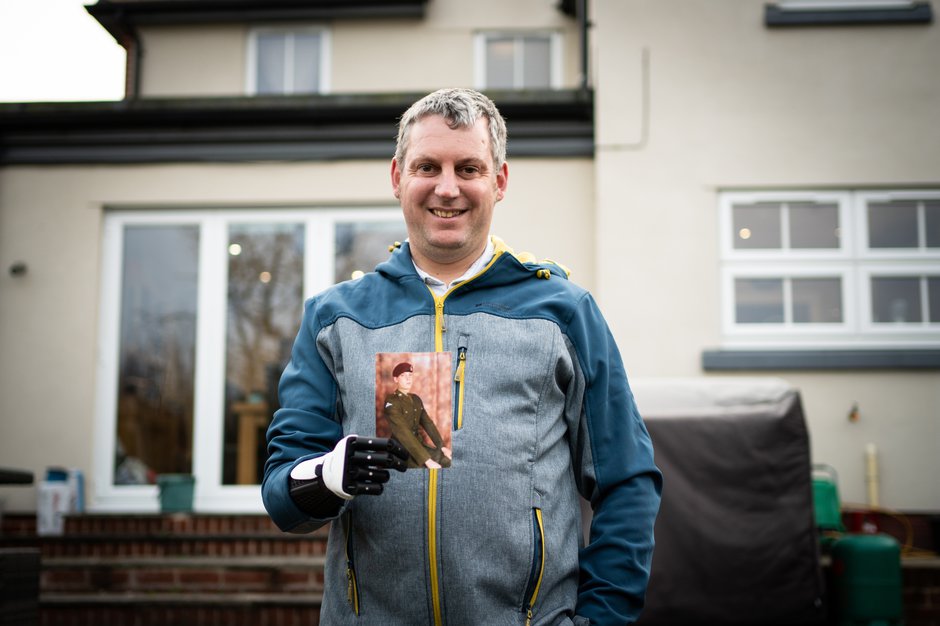 Image by: Simon Galloway
Image by: Simon Galloway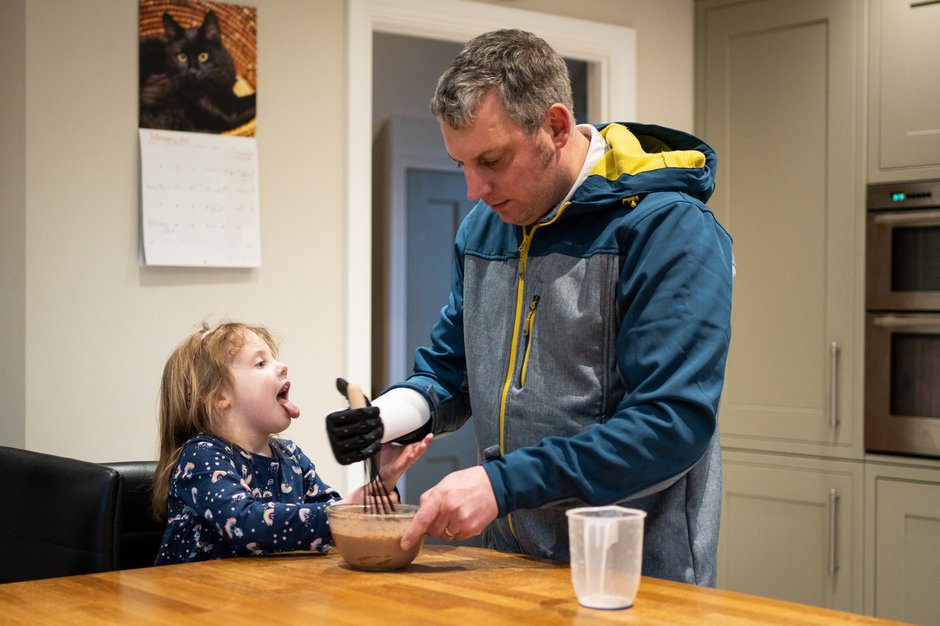 Image by: Simon Galloway
Image by: Simon Galloway
Daz said: "I ducked as the mortar went off and then looked down to see half my arm was missing, there was blood everywhere.
"I wasn't in a huge amount of pain, I was just thinking, 'will I see my girlfriend and son ever again, will I survive?'
"It was such a surreal moment because even though you're a serviceman you think losing a limb isn't the kind of thing that will ever happen to you."
Daz thought he was "going to die" in the immediate aftermath of the incident and then, as the months wore on, he went through a period of denial over what happened.
He said: "I had a range of different emotions as time wore on but eventually I accepted the situation I found myself in and moved on.
"It wasn't easy because I was right-handed, so I had to learn how to do everything all over again with my left, which was a huge challenge."
Over the past decade Daz has tried a number of prosthetics but found none of them worked exactly how he wanted, until he got the bionic Hero Arm this year.
He said: "The functionality is absolutely amazing, I can make the smallest movements with it.
"I've tried all sorts of prosthetics over the years and the Bionic Arm is by far and away the best of the lot - it's absolutely brilliant.
"I really believe it's going to improve my life massively."
The prosthetic has given him the ability to do things with his daughter such as paint, bake and do crafts.
The former serviceman, who was medically discharged in 2014, received funding for his Hero Arm through the NHS Veterans’ Prosthetics Panel, which is a pathway for veterans who have lost a limb while serving.
The prosthetic can be purchased by civilians in the UK for around £10,000.
Daz was also supported by Blesma, a limbless veterans’ charity which he currently works for as an outreach officer.
He said: "Hopefully I'm the first veteran of many to receive a Hero Arm.
"There are many others like me who could really benefit from such an amazing prosthetic."
Video by: Ellis Wylam
A globetrotting dad who has travelled to over 100 countries has recreated 20 in is back garden for his kids
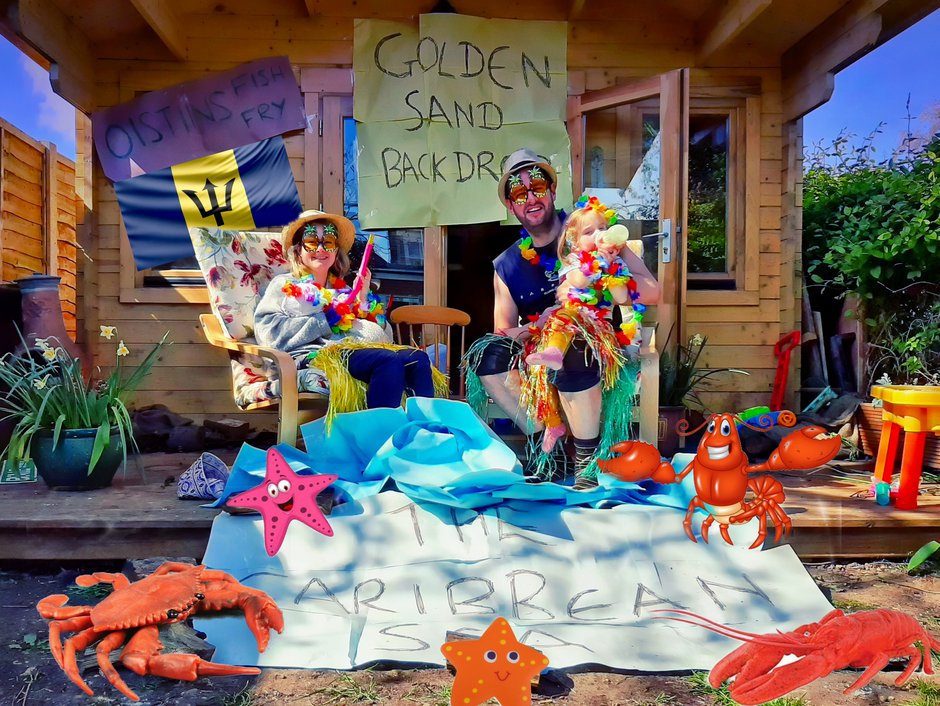 Image by: Matthew Newby SWNS
Image by: Matthew Newby SWNS
A globetrotting dad who has travelled to over 100 countries has recreated 20 in is back garden for his kids.
David Nash, 41, has used a variety of props to make DIY versions of some of the planet's most beautiful places.
He has recreated the Nile River and Venezuela's Angel Falls as well as scenes from France and Cuba in his garden, shed and roof.
David has used his garden to build Peru, Japan, USA, Morocco, Thailand, Panama, Venezuela, Brazil Trinidad and Barbados.
His children have also enjoyed trips to Sri Lanka, China, The Netherlands, the UK, Ireland, Bhutan, Russia, Egypt, Iceland, Australia and Italy.
The 41-year-old, from Sible Hedingham, Essex, got creative for partner Emma and their two daughters Rose, two, and Ruby, four months.
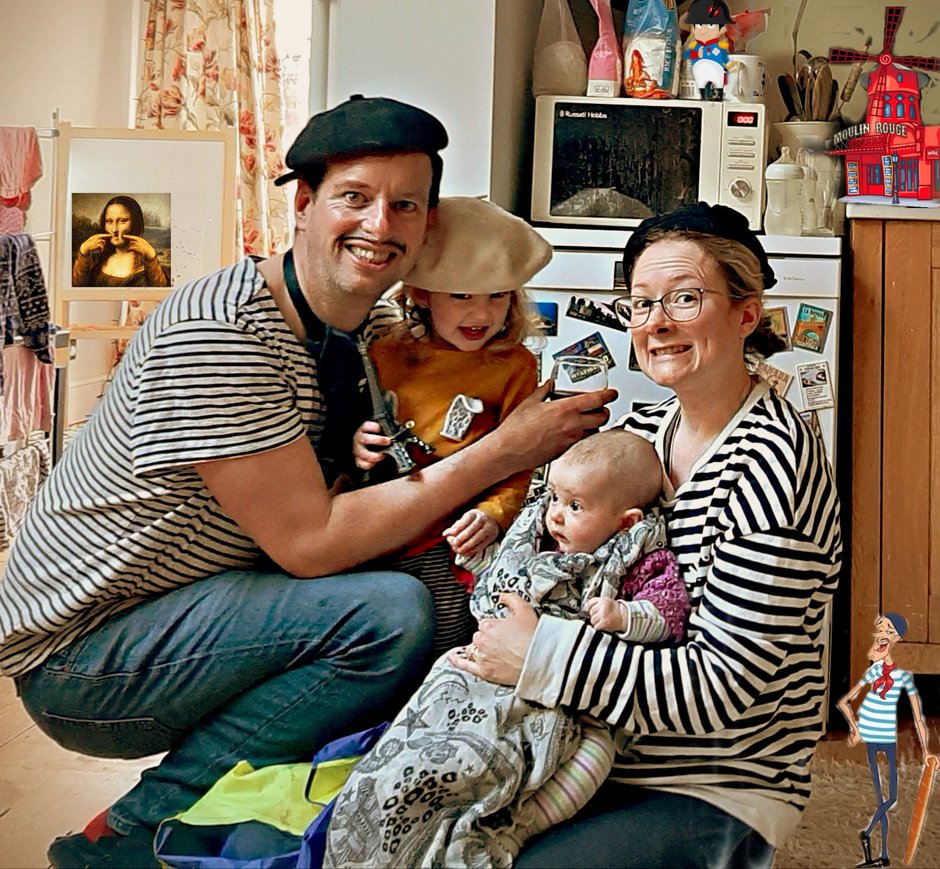 Image by: Matthew Newby SWNS
Image by: Matthew Newby SWNS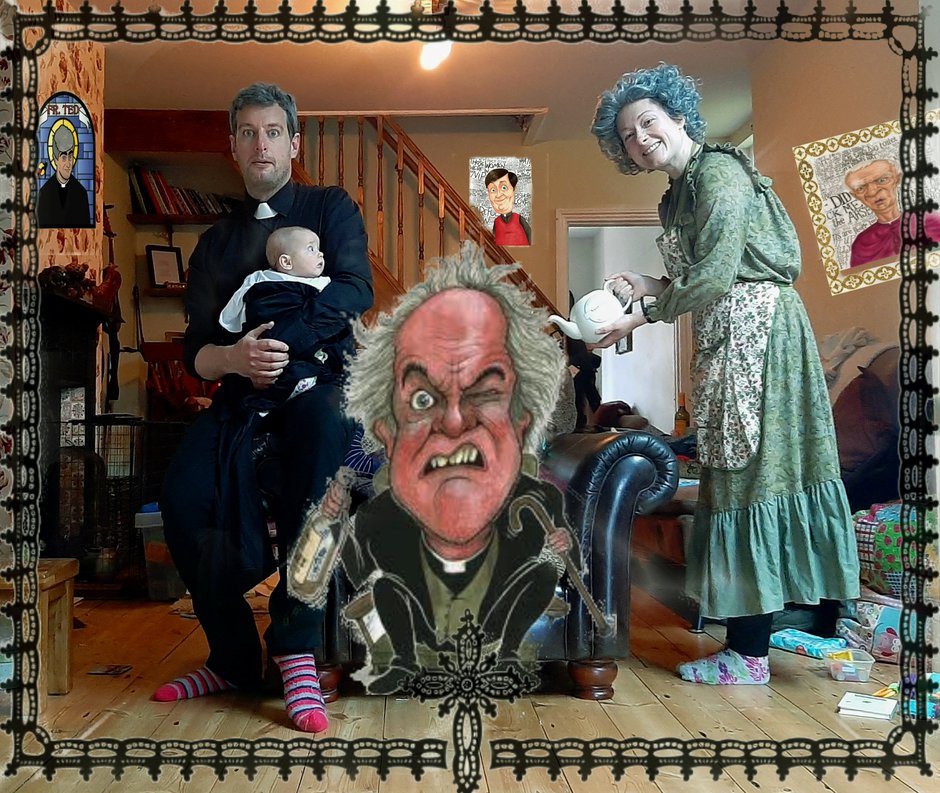 Image by: Matthew Newby SWNS
Image by: Matthew Newby SWNS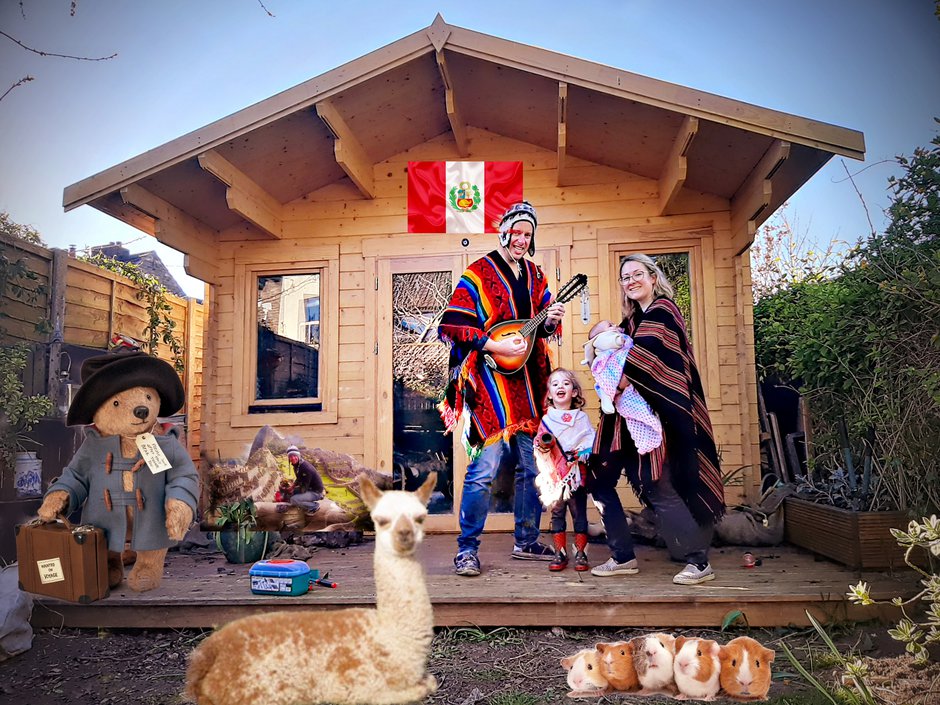 Image by: Matthew Newby SWNS
Image by: Matthew Newby SWNS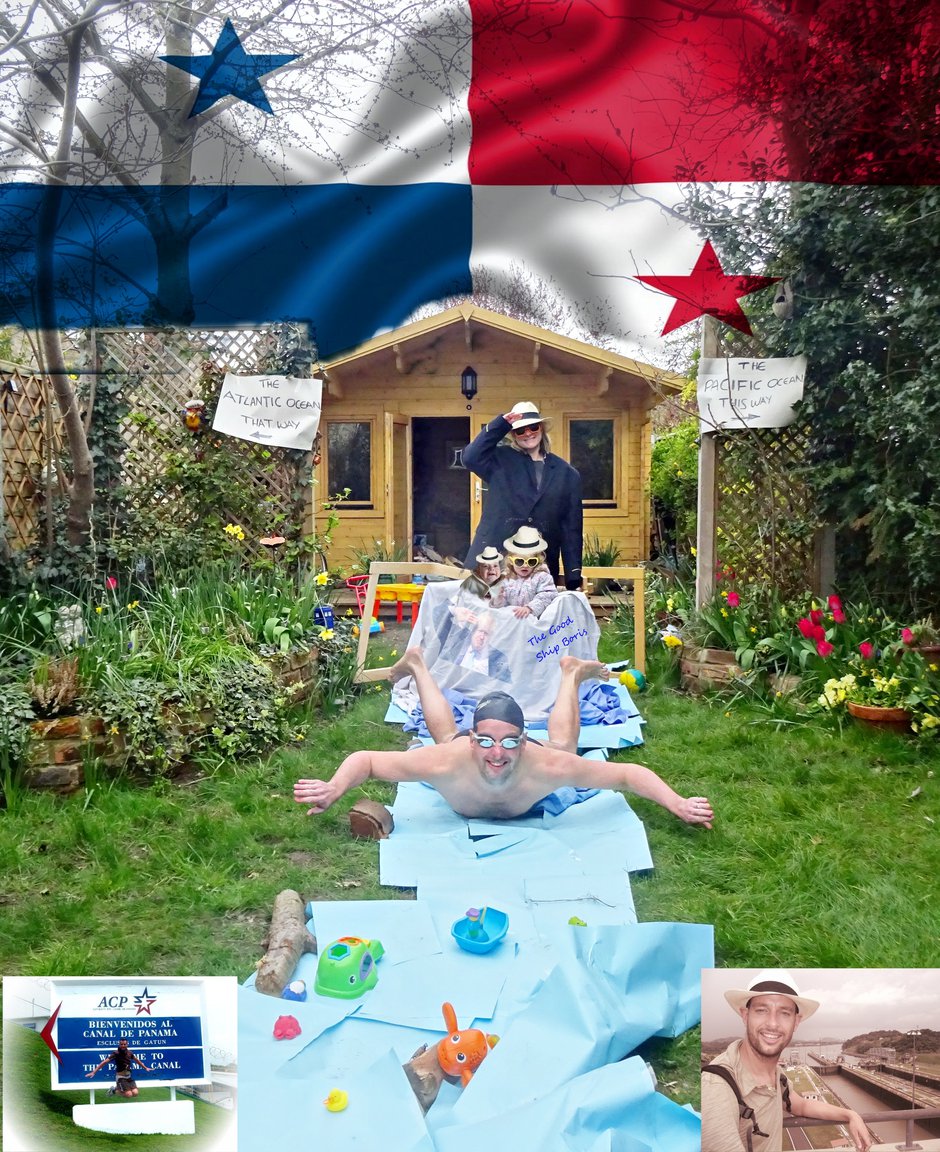 Image by: Matthew Newby SWNS
Image by: Matthew Newby SWNS
David, assistant headteacher at Hedingham School, said: "I have tried to bring the essence of each country out while portraying it in a humorous way.
"I've recreated famous scenes from each country, just from using scraps around the house that I've collected from all the places I've been.
"I've made the Nile River and the Panama Canal from painting old cereal boxes."
He added: "We are all aware of how awful the situation is at the moment - but it has made us all slow down a bit.
"It's giving us time to make things like we used to do - from scraps and from boxes and things like that.
"The aim of this, more than anything, is to keep spirits up, and keep people smiling during a tough time."
David has travelled to 105 countries in his life, and has so far recreated 25 of them in his garden since the beginning of the lockdown.
He has created a Sri Lankan themed night, and a funny Australian scene where he fashioned himself an outfit out of Fosters boxes, and donned an Australian cork hat.
And David has also created a Caribbean beach scene, inspired by his honeymoon with wife Emma - during which the couple visited 11 Caribbean islands.
David said: "One thing you find when you travelling particular countries like India or Central America, is that you can’t rush things.
''There is a lot to take in and it takes time.
"We’ve turned into a very 'hurry-hurry' culture - if there is one silver lining in all of this is that people have realised the importance of spending time with each other."
He added that he has drawn inspiration for using household items from seeing children in some of the countries he has visited doing exactly the same thing.
David, who fashioned a rickshaw out of a large milk carton, said: "I remember in Ethiopia we saw exactly that, one of these Tuk Tuks made out of old oil cans.
"In South Africa, kids were using bricks as cars.
"The joy of doing this with my two-and-a-half year old daughter is that children tend to have that creative imagination, a willingness to believe anything can become anything."
David said that some of his favourite countries that he's visited include Bhutan, in south Asia, Japan, and Holland.
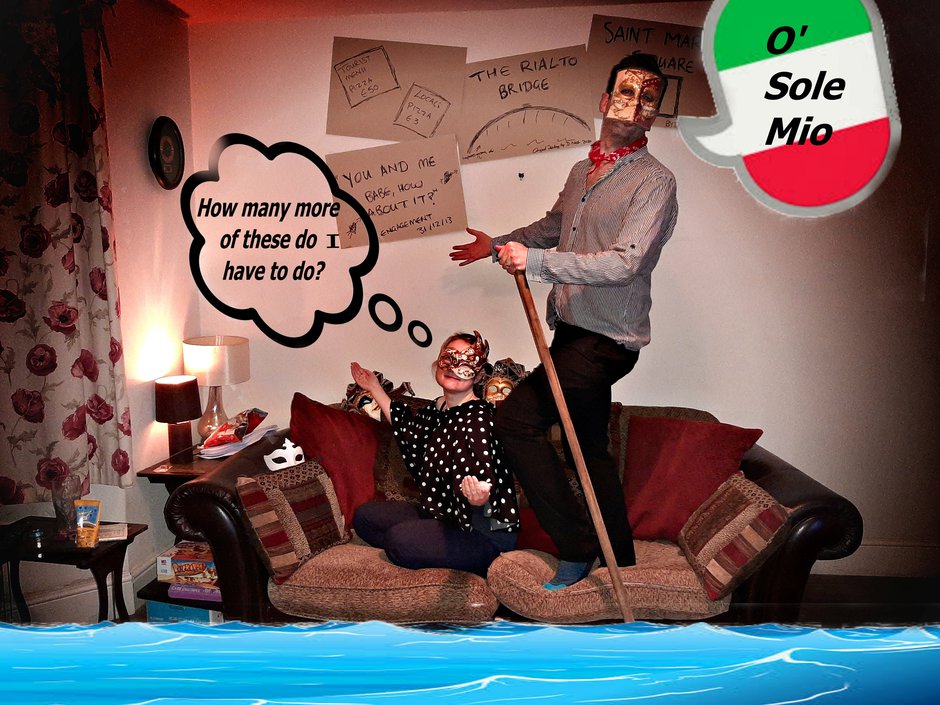 Image by: Matthew Newby SWNS
Image by: Matthew Newby SWNS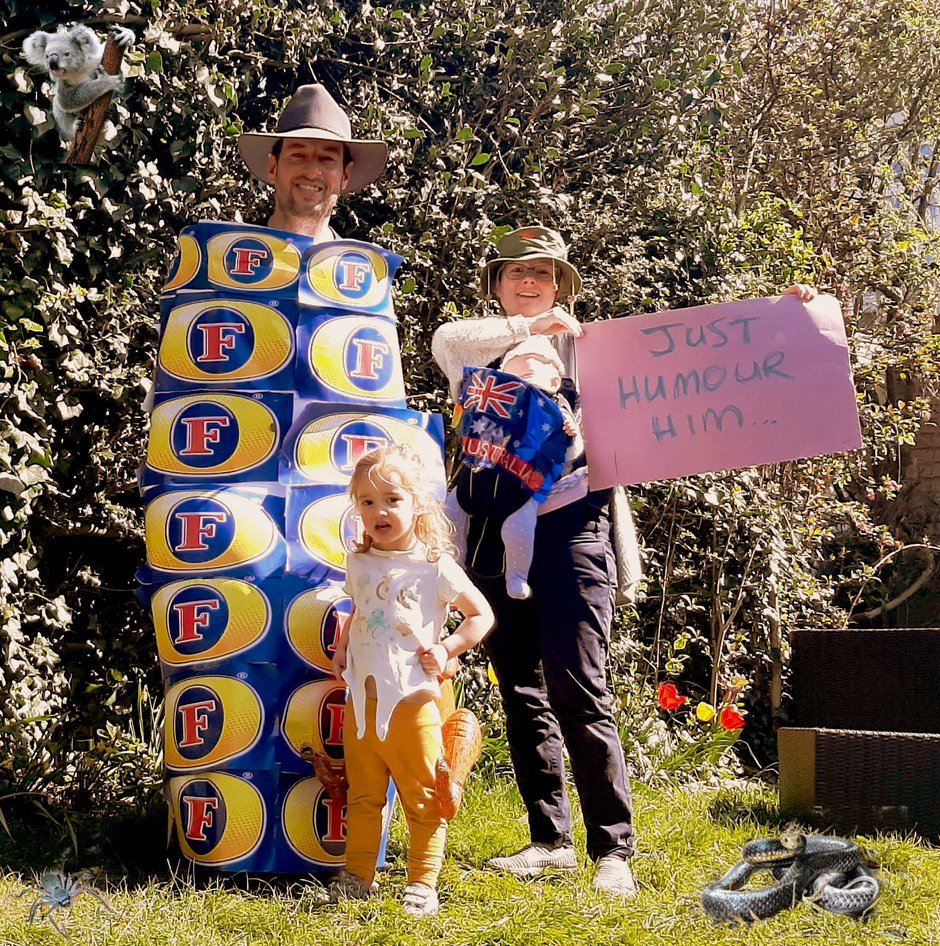 Image by: Matthew Newby SWNS
Image by: Matthew Newby SWNS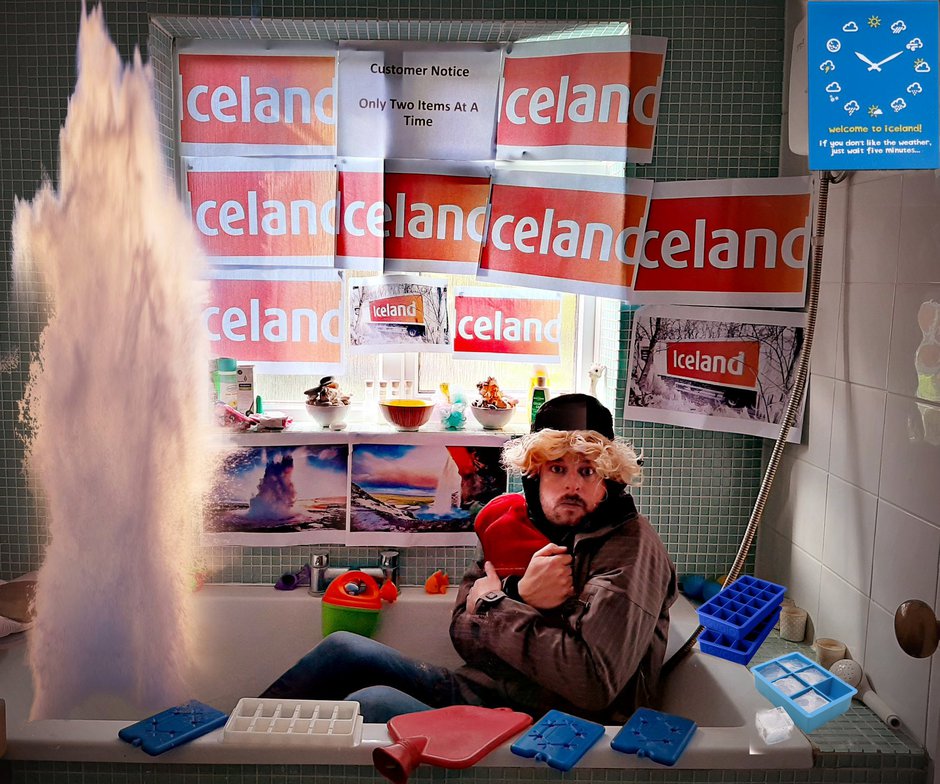 Image by: Matthew Newby SWNS
Image by: Matthew Newby SWNS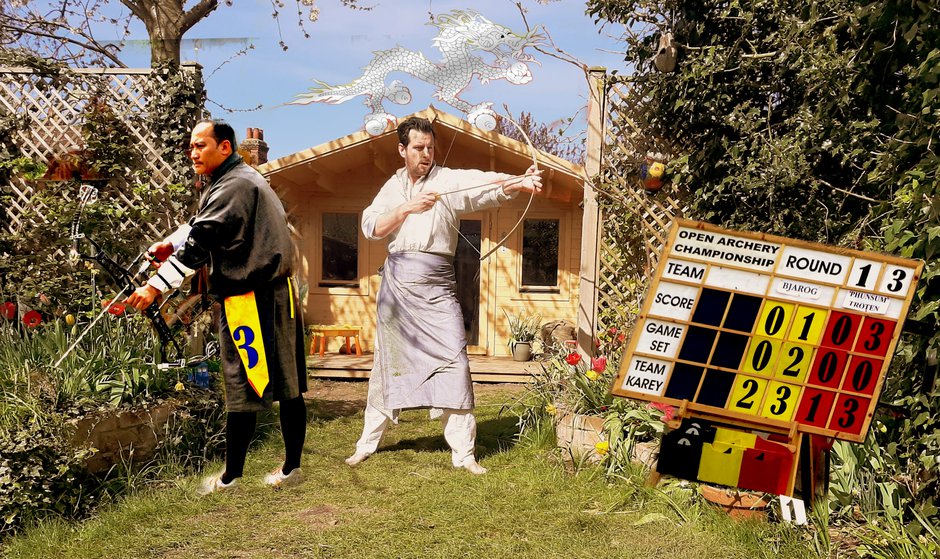 Image by: Matthew Newby SWNS
Image by: Matthew Newby SWNS
He said: "We've done Bhutan as one of the countries in our garden.
"They measure wealth there in terms of happiness, rather than economic prosperity.
"They have famous funny signs at the side of the road, that say things like 'After drinking whiskey, driving is risky'.
"So we recreated some of those in our garden, but made them more topical to here.
"I did Holland last week, too - I put some clogs in the sink, and told my wife that the sink was clogged," David joked.
David added that he hopes bringing a taste of each country to his home can enrich his daughters’ lives during lockdown - as well as the lives of his followers on social media.
 Image by: Matthew Newby SWNS
Image by: Matthew Newby SWNS Image by: Matthew Newby SWNS
Image by: Matthew Newby SWNS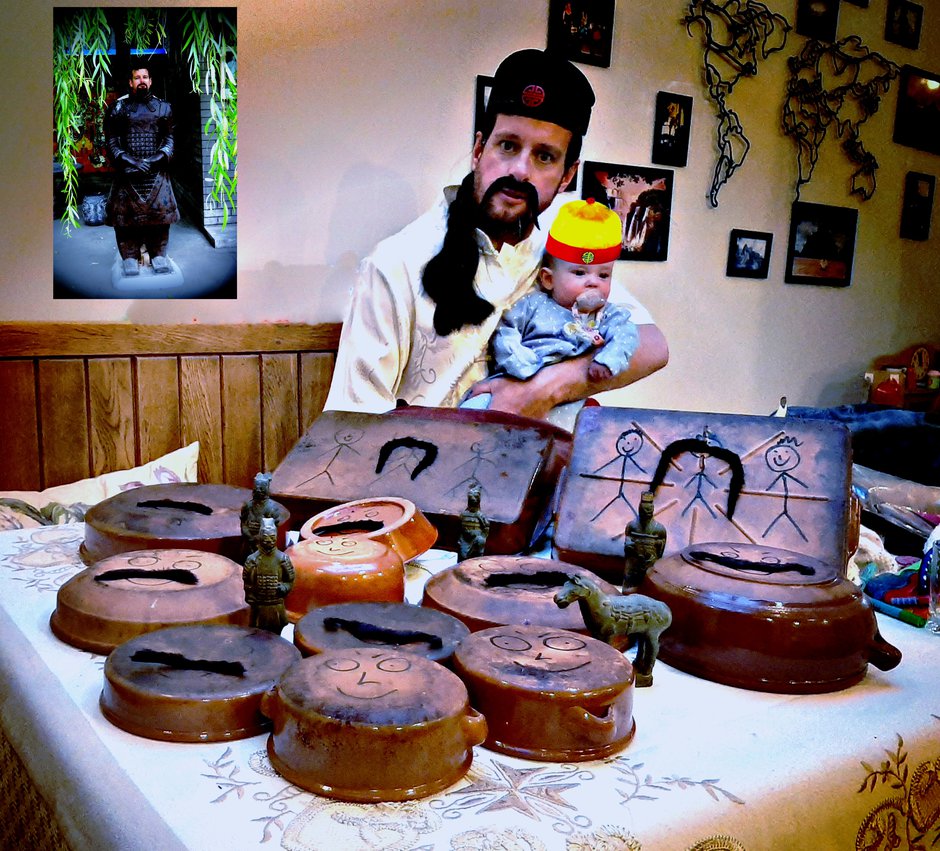 Image by: Matthew Newby SWNS
Image by: Matthew Newby SWNS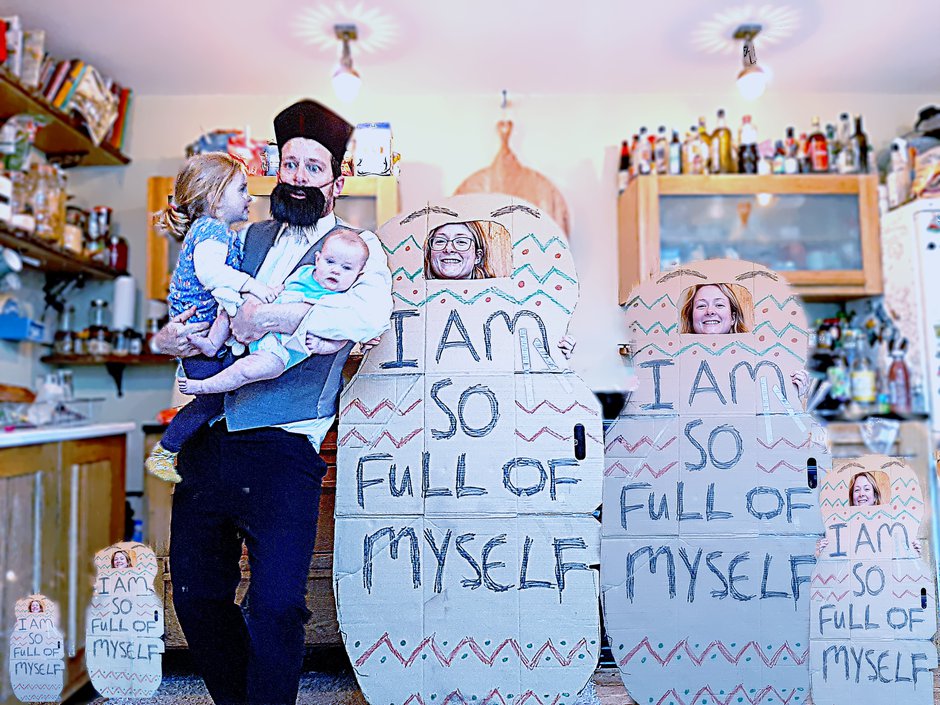 Image by: Matthew Newby SWNS
Image by: Matthew Newby SWNS
He said: "We haven't been able to do as much travelling in the last couple of years, with two young children - especially with the younger one.
"But at least now they'll have some funny photos to look back on, and know about some of the countries their dad has been to."
He added: "I feel very lucky, I’m healthy and my family’s healthy, I’ve got a wage, whereas a lot of people out there have an uncertain future.
"Experiences you have while travelling help you to gain perspective. You miss the most basic things - and I think that's what this current situation has taught us.
"With panic buying, this is the first time in our lives we’ve thought 'are we going to have to do without these things we need'. It's woken us up slightly."
Incredible bond between a dog and a rhino captured on video
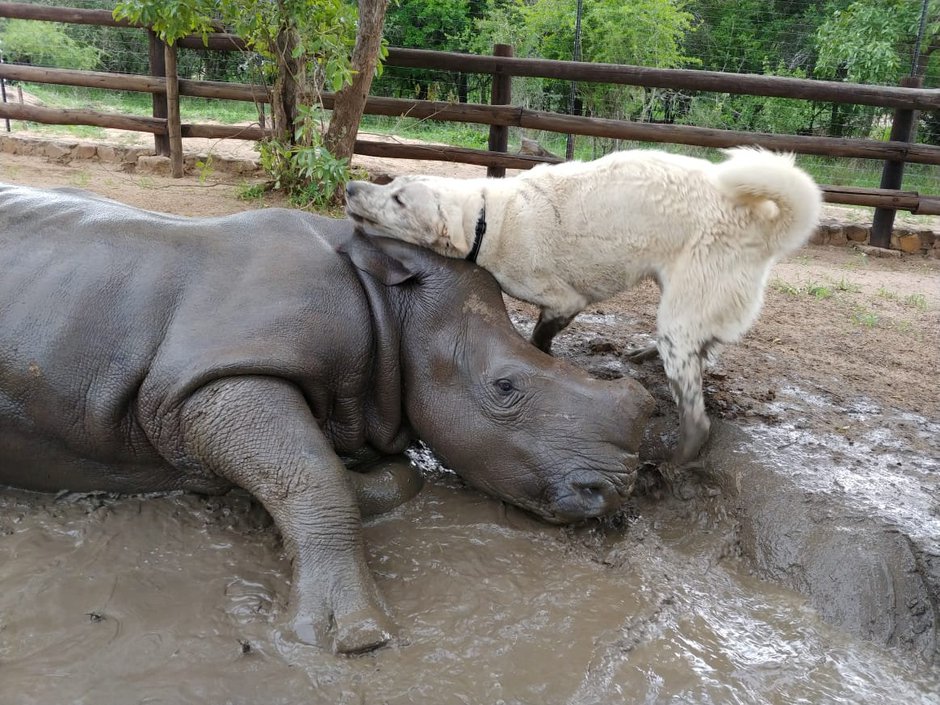 Image by: Hoedspruit Endangered Species Centre
Image by: Hoedspruit Endangered Species Centre
A "remarkable and unbreakable" friendship between a dog and a RHINO has been captured on video.
The sweet pairing can be seen doing everything together - with the rhino even giving the dog a kiss.
David is an Anatolian Shepherd and Esmé is a white rhino.
Despite their differences, the two are clearly fond of each other's company.
In one video, Esmé can be seen to kiss the head of David.
In another, David playfully chases Esmé across a field.
Both are resident to Hoedspruit Endangered Species Centre (HESC), a South African wildlife facility focused on conservation of rare and vulnerable species.
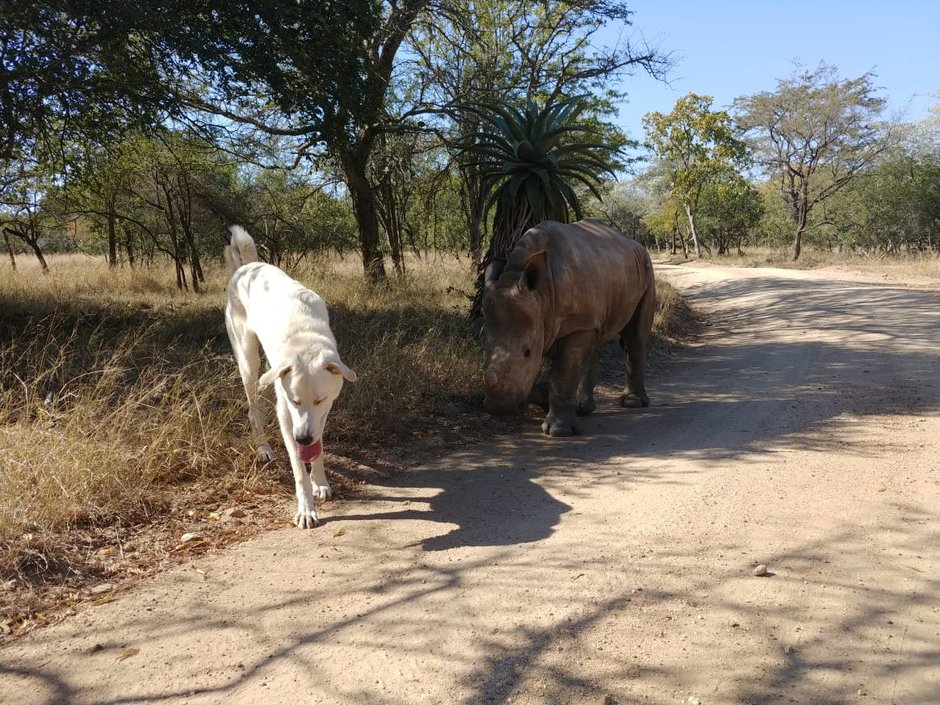 Image by: Hoedspruit Endangered Species Centre
Image by: Hoedspruit Endangered Species Centre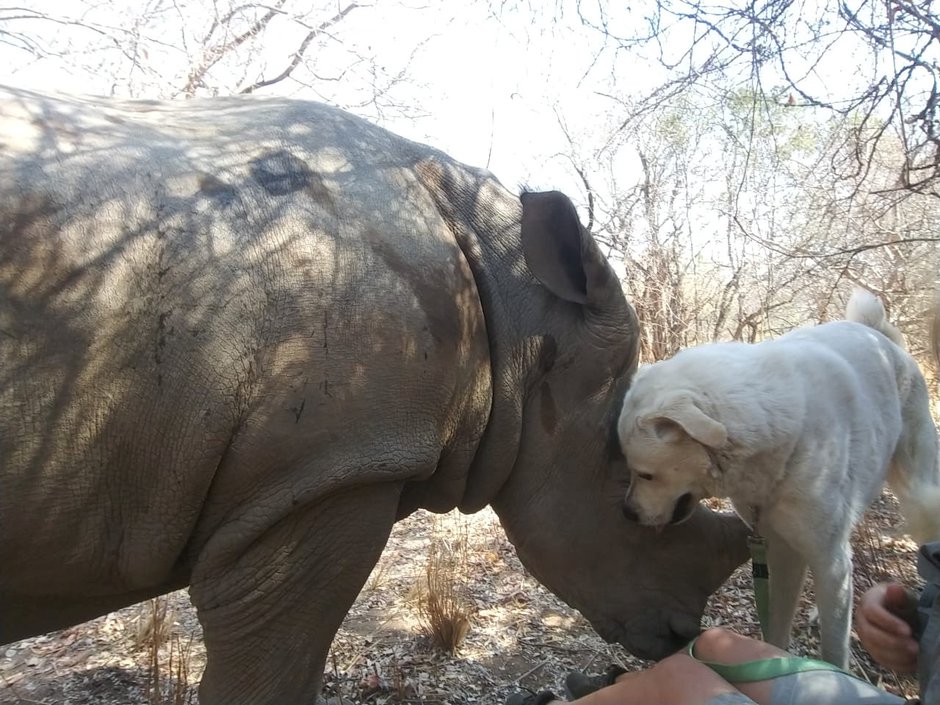 Image by: Hoedspruit Endangered Species Centre
Image by: Hoedspruit Endangered Species Centre
The founder and managing director of HESC Lente Roode, 72, says the unique bond the two animals share is important to her.
"Esmé was our first rhino calf that we decided to introduce to an anatolian shepherd dog as a companion.
"It took a few days but as soon as the two were used to each other the relationship was remarkable and unbreakable.
"Esmé and David have a very special relationship and are therefore very dear to me."
David the dog is nearly two years old and was donated to HESC by a friend to Lente.
Esmé upbringing was slightly more challenging.
"Her mother was a young and inexperienced cow and couldn’t produce milk for Esmé," Lente said.
"On Esmé’s arrival she was extremely malnourished and as a result pressure sores formed on her ankles and underneath her feet."
Video by: Gabriella Petty
This pet raccoon rides in a boat, uses a litter box and is best friends with a golden retriever
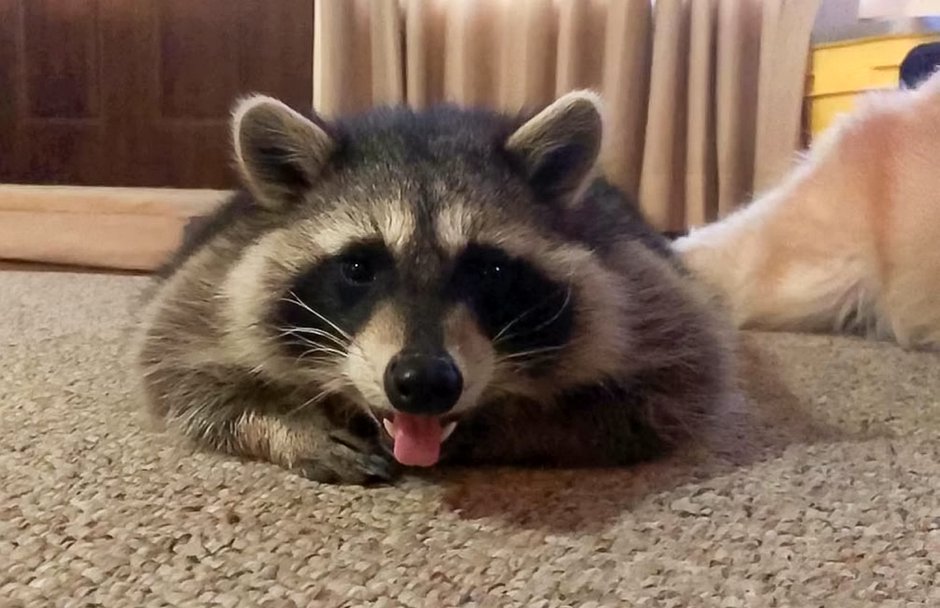 Image by: Caryn Williamson
Image by: Caryn Williamson
Meet Rebel - the pet raccoon who rides in a boat, uses a litter box and is best friends with a golden retriever.
“For most people, a raccoon is not a good pet,” said Rebel’s owner, Caryn Williamson, 44, who lives in Hudson, Indiana.
“They require constant supervision and they are so much more intelligent than a dog or cat.
“They can literally unlock your front door and walk right out.”
Rebel’s full name is Rebel Raccoon the Bush Brat.
“But he also answers to Booby or Booby Baby or Boobear,” said Caryn, who is the manager of an HVAC company for heating, ventilation, and air conditioning.
“Most raccoons won’t answer to their owners but he will answer me and come when I call him, it’s pretty cool!”
Caryn says she adopted Rebel, who will be a year old in April, from a breeder in Ohio via the United States Department of Agriculture.
“I got him September 9th of 2019 and I’m currently on the list for a baby raccoon, from the breeder.
“We got him from a young couple when he was just under five months old.
“Exotic pets like raccoons can’t be brought to a shelter or humane society and they can never be released into the wild.
“They are euthanized unless you can find someone willing to adopt them. We took on the challenge!”
Rebel quickly settled into Caryn’s home and became firm friends with her eight-year-old golden retriever Remington.
“Rebel and our dog Remington get along great.
“They are best friends, so much so that when Remington goes outside, Rebel paces back and forth at the door chattering until his friend is back.”
 Image by: Caryn Williamson
Image by: Caryn Williamson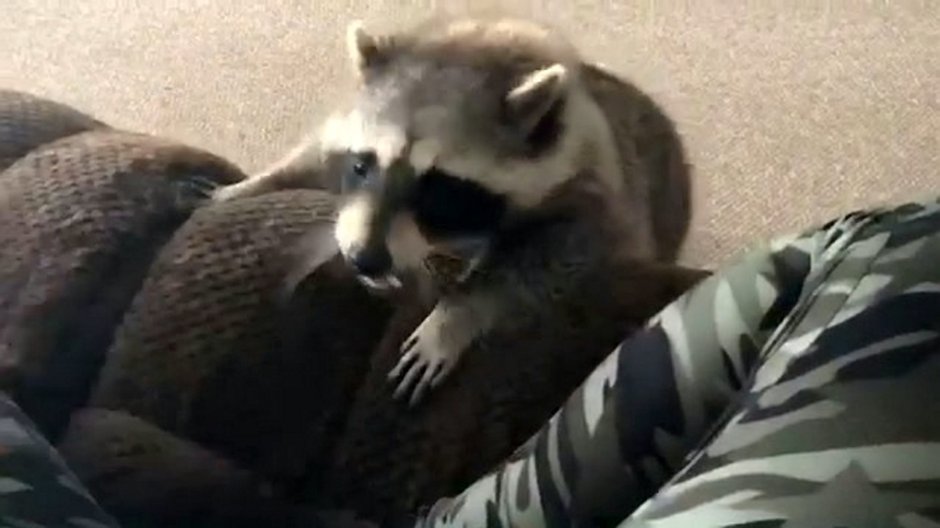 Image by: Caryn Williamson
Image by: Caryn Williamson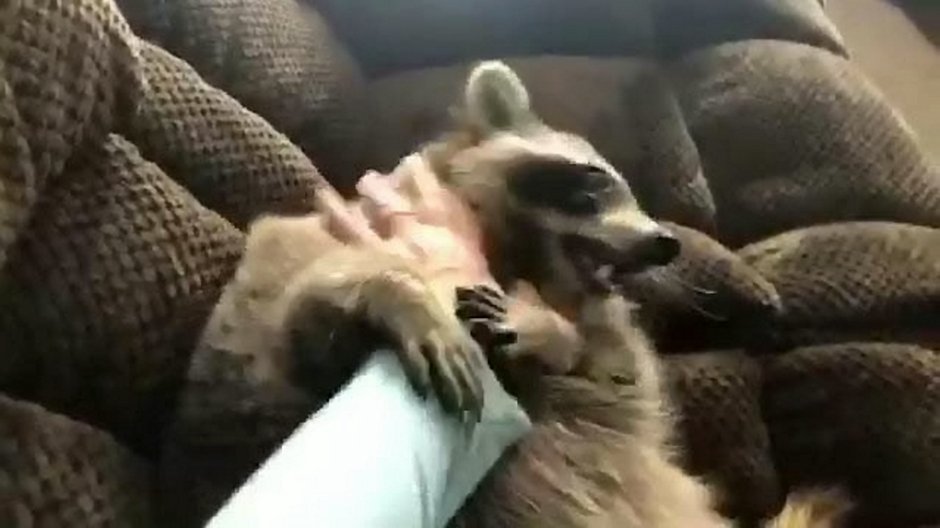 Image by: Caryn Williamson
Image by: Caryn Williamson
As for Rebel’s day-to-day care, Caryn confirmed that raising a raccoon comes with certain complications.
“Raccoons are pack animals so being alone is not good for them,” she said.
“They need either animal or human companionship at all times.
“Rebel lives indoors at all times unless he is outside under our supervision. We live on a lake, and he goes for boat rides all summer. He is neutered, and has all recommended vaccines, and regular veterinary check ups.
“In order to maintain our exotic pet permit we are required to have vet checks and home checks by the Department of Natural Resources (DNR).
“Raccoons can’t live in cages. They get too stressed. But we do have to have a safe place to put him away and secure him for our permit.
“He has a Critter Nation enclosure that has a hammock in it that he likes to sleep in, and he goes in there when he wants to be left alone.
“He also has a feeding cage. Raccoons are messy eaters so I stay a step ahead.
“Raccoons eat what we eat, it’s a balance of meat and protein and fruits and vegetables.
“He loves eggs, and eats one every day for breakfast. He also gets a raw chicken leg once a week and eats it bone and all.”
Caryn’s lifestyle in rural Indiana allows her to keep Rebel without incident, but she doesn’t believe the species is ready to be fully domesticated.
“Maybe in a few hundred years,” she said.
“Rebel uses a litter box just like a cat and they are trainable to an extent, but raccoons are very stubborn and will only listen to commands when they want to.
“To live with a raccoon you must live on their time and their schedule. I have a very flexible schedule, so it works…but it wouldn’t work for the average person.
“Living with a raccoon is learning their moods and body language. It’s a daily struggle to entertain them.
“But the cuteness and love they exude far outweighs the trouble and mischief they cause.”
Video by: Gabriella Petty
Meet the air hostess who gets asked if she is Meghan Markle by baffled passengers up to ten times A DAY
 Image by: Christine Mathis
Image by: Christine Mathis
An American air hostess who looks like Meghan Markle has been confusing passengers - and says she gets mistaken for her ten times a DAY.
Christine Mathis, 32, is an air hostess for JetBlue airline and has been getting mistaken for Meghan Markle ever since she starred in the TV show 'Suits' in 2011.
As Meghan's fame grew and her relationship with Harry appeared in the press regularly, doppelganger Christine from New Jersey was stopped more and more.
Now, the mum of one claims she gets approached up to ten times A DAY by passengers and members of the public who are convinced that she's a celebrity.
After years of being mistaken for the famous actress, Christine has signed up with an agency to find work as a lookalike.
Christine said: "I started getting mistaken for Meghan years ago when I worked in first class - passengers would stop me and say I looked like 'that girl from Suits'.
"It happened a few times so I obviously googled Meghan and it was really flattering - she's absolutely stunning, so it's definitely a compliment.
"I do see the resemblance! Meghan and I are both mixed race - my dad is African American and Italian and her mom is African American, maybe they're related somehow!
"When she started dating Harry, I was getting stopped more and more, and when they got married, it became a daily occurrence of people asking me if I was Meghan.
"I flew from LA to New York for work one day and security thought that I was her until they checked my passport which was hilarious.
"I also had a mole removed and my dermatologist was convinced that I was Meghan and just using a fake name to get the work done secretly!
"Passengers always tell me I look like her and say to me 'You're married to a Prince, why are you working as an air hostess?'"
"It happens so often but I really don't mind it, she's an amazing woman so it's really flattering to be mistaken for being her."
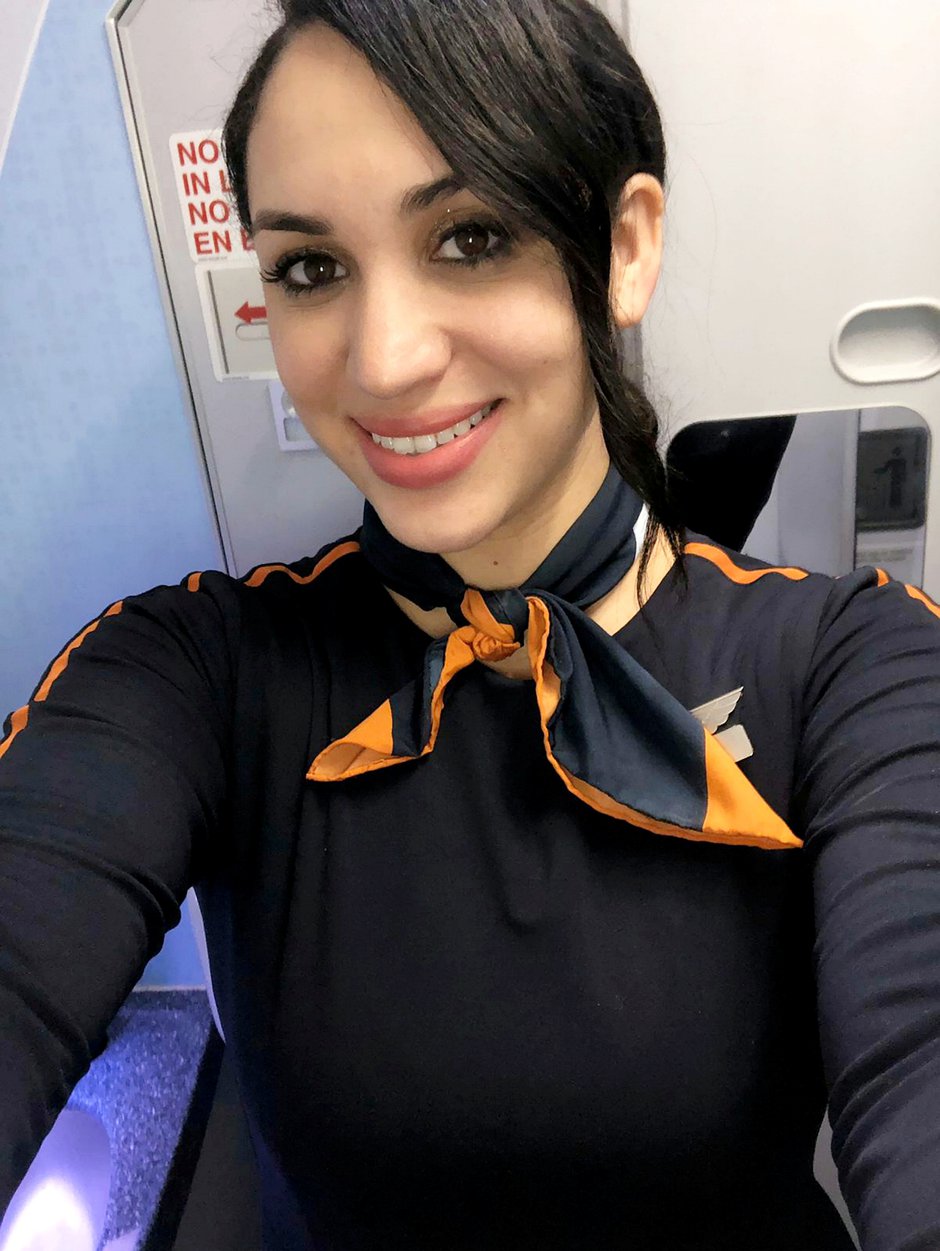 Image by: Christine Mathis
Image by: Christine Mathis Image by: Christine Mathis
Image by: Christine Mathis Image by: Christine Mathis
Image by: Christine Mathis Image by: Christine Mathis
Image by: Christine Mathis
Although looking exactly like Meghan, Christine found her own prince long before the actress, falling in love with warehouse supervisor Pablo Smith, 37, in 2012.
The couple also became parents before Meghan and Harry, welcoming their daughter Alana in February 2018.
After years of being mistaken for the famous actress, Christine has signed up with an agency to find work as a lookalike.
She's already done a photoshoot with a Harry lookalike for the agency so she can start getting work as Meghan.
Christine said: "I've wanted to be an actress ever since I was a little girl and people are so convinced that I am actually Meghan that I thought why not see if I can get some jobs pretending to be her.
"I want to do corporate and TV work, but my absolute dream would be to play Meghan in a Lifetime movie about her.
"I only just signed up to an agency, and have already done a shoot with a Prince Harry lookalike which was a lot of fun but also weird pretending to be with another guy!
"We did the shoot at the Terranea resort and we were stopped at least 20 times. People were even taking pictures with us, it was a really fun experience.
"A lot of men do stop me to tell me I look like Meghan and use it as a kind of chat up line, which is bizarre, but I'm very happy with my boyfriend.
"Pablo does see the resemblance between Meghan and I, he does get why people think we are the same person.
"He gets teased a lot by his friends who say that he's Prince Harry, but he actually looks nothing like him - he looks more like John Legend!"
 Image by: Adam Gray SWNSVideo by: Ashley Moran
Image by: Adam Gray SWNSVideo by: Ashley Moran
Police community support officers are captured playing HOPSCOTCH
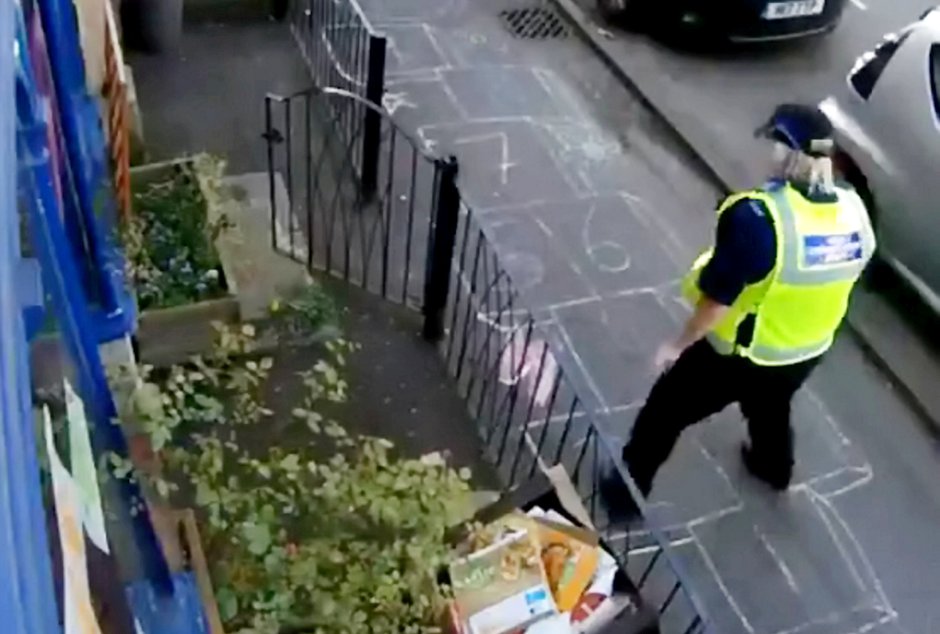 Image by: Lis Bailey-Bowler
Image by: Lis Bailey-Bowler
A pair of police community support officers have been captured on camera playing a game of HOPSCOTCH in the street while on duty.
Comical footage captured the uniformed officers hopping and skipping along the pavement after the markings were painted on the floor by a five-year-old boy.
Derbyshire Police shared the clip after the pair were unwittingly caught on CCTV while on patrol in Matlock, Derbys., on Tuesday (14/4).
The force wrote on Twitter: "Officers in #Matlock have been #CaughtOnCamera... using a hopscotch that a 5-year-old had painted on the floor outside his house.
"Thank you to mum for sharing this footage with us, and to the PCSOs for hopscotching like no-one was watching!"
The force's Police Contact Centre had earlier tweeted: "Matlock SNT hop, skip and jumping whilst on patrol yesterday!
"Ted Bailey-Bowler (5) with a little help from Mum used his chalks to make some fun for anyone going past and we love it!
"In these difficult times it is important to share things that make others smile! #thankyou."
Many social media users praised the pair for brightening their day but others were more critical of their actions.
Stephen Carruthers wrote: "Essential travel? No. They clearly left their homes to play on a hopscotch! NOT essential travel."
Jamie Burgess added: "Should be out catching crooks instead of hopping about the streets. What is this nonsense?"
A web user called Right Hand Of Doom added: "P**s poor social distancing chaps ! Lead from the front be the example."
Dan Oldfield said: "Surprised that the parents haven’t been fined for it as it’s proof they havent been staying in there home"
However, Zoe Parnell put: "Lovely x keep up your amazing good spirits officers x keep safe x"
Fran Jones added: "Ignore any haters, this is heartwarming to see. Police are human too. In these strange times, we all need a lift."
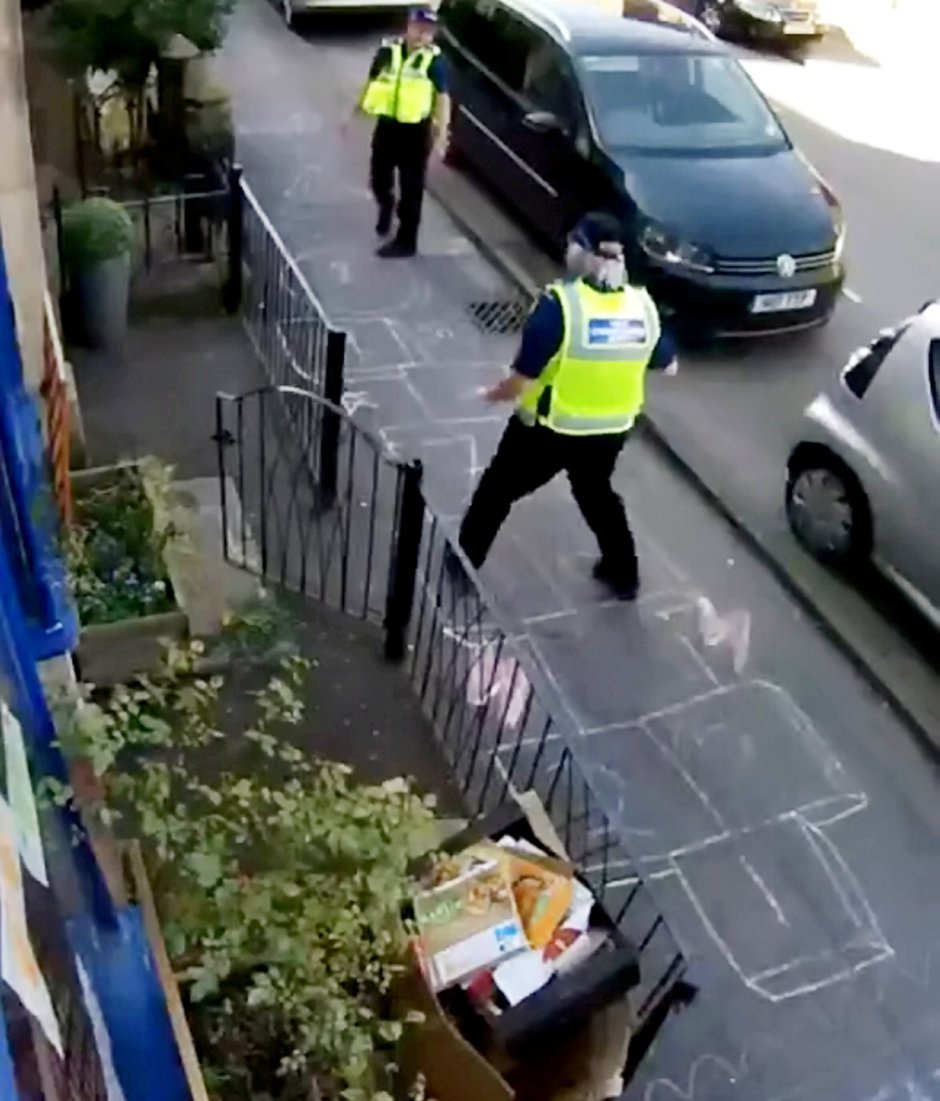 Image by: Lis Bailey-Bowler
Image by: Lis Bailey-Bowler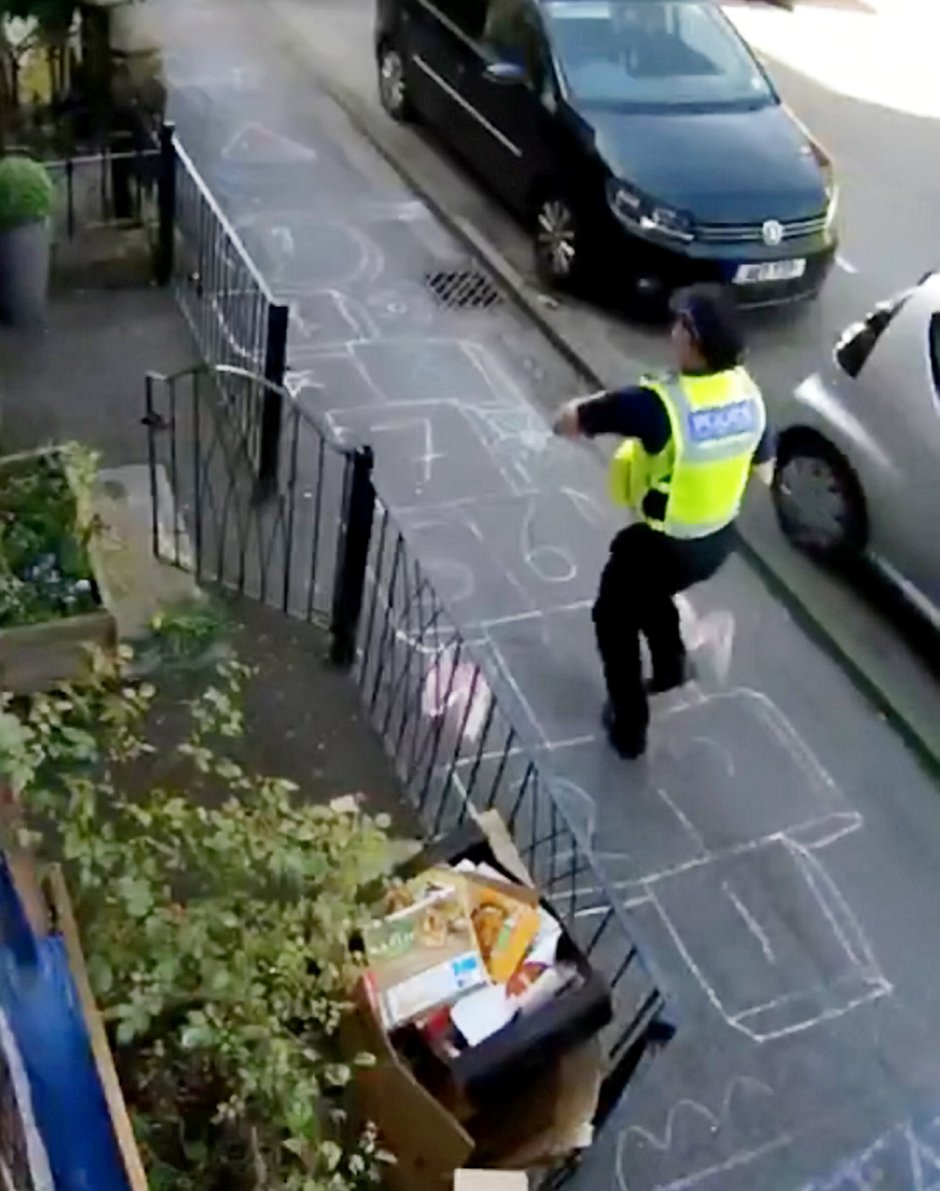 Image by: Lis Bailey-Bowler
Image by: Lis Bailey-Bowler
Ted's mum Lis Bailey-Bowler, 38, said passers-by regularly have a go on the hopscotch but was shocked to see the officers giving it a try.
Mum-of-two Lis, a primary school teacher, added: “It think it's great. It has made a lot of people smile and that’s what we need at this time.
“It was filmed on our security camera, which we have because we are on quite a busy road.
“My son Ted had wanted to make a hop-scotch and went out with his dad on Easter Monday with the chalks he had got for his birthday a couple of days before.
“I first realised they might have had a go because of a post on the Matlock Community Support Facebook page. They’d posted a picture of officers standing by the hopscotch.
“I recognised it was outside my house and asked them online if they’d had a go. They said: ‘Yes, we did.’
“Then I had a look on the camera to show Ted and found it after scrolling through for ages.
“It took 20-40 minutes until I saw people in high visibility jackets going by.
“I called Ted in from the garden and showed it to him. He thought it was really great and funny and liked it when they stumbled at the end.
“Some of our friends have also tripped up there. It’s regular hopscotch from one to ten with four random triangles and circles at the end.
“Ted thinks no one can do it better than him.
The officers said when we can see people again they would like to come to meet Ted properly.
“I think it’s lovely especially because Ted had his birthday party in lockdown and couldn’t see his friends.
“Having a video call with them wasn’t the same, so anything to cheer him up is welcome.
“This has kept me busy for the past few days with the video going viral. It’s been really weird.
“I’m glad people are enjoying it.”
Video by: Gabriella Petty
A bored university student spent her time in quarantine on the phone to all her exes - to ask them 'What Went Wrong? in their relationship
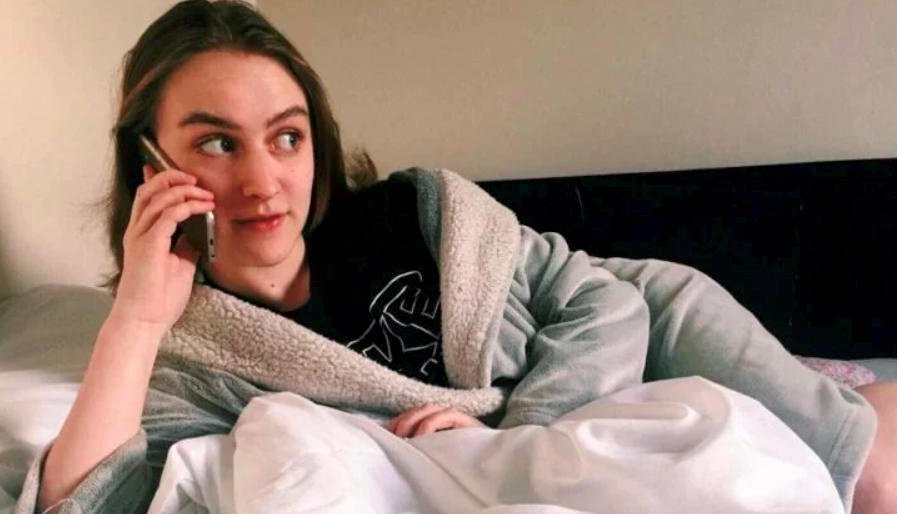 Image by: Jack Rivlin
Image by: Jack Rivlin
A bored university student spent her time in quarantine on the phone to all her exes - to ask them 'What Went Wrong? in their relationship.
Rebecca Lockwood followed advice she’d seen on Twitter - treat isolation as an opportunity for self growth.
She'd spotted a Kitty O’Meara quote making the rounds on Twitter: “And the people stayed home. And read books, and listened and rested, and exercised, and made art, and played games, and learned new ways of being, and were still.”
So the English and creative writing undergrad thought who better to help her grow than her exes.
Rebecca, 19, shared her experiences with student news site The Tab.
She said: “The people who have experienced the worst of me are definitely the most qualified to tell me what went wrong and how to improve.
“It’s worth a try to see how I can be the best me I can be.
“Plus, I really didn’t have anything better to do - I was just so bored.
“Waiting for them to reply was terrifying, but actually everyone was really nice - there’s no hard feelings there.
“It gave me a bit of a reality check - it’s so easy to just block someone out of your life.”
Call number one was with Jay, an ex-boyfriend of multiple months dating back to last year.
Jay had lived opposite Rebecca in her first-year accommodation and the pair were two of few resident smokers.
She’d broken up with him in bed.
When she called him last week, he admitted he had no idea who he was talking to because the number wasn’t saved.
Jay said: “I think initially everything was really great because we were both available, living super close and the thrill of it all was the sorta uni vibe you would want.
“After thinking it through for a while, I guessed you probably thought that yes I’m nice and I look after you, but that you aren’t getting the most out of someone you should be fully committed to.
“I don’t believe you made any wrong conscious choices, and neither did I.”
Call two was with Tim - the pair had dated for a couple of months about three years ago.
The pair had started out as friends with few common interests - the extent being photography and Tyler the Creator.
Rebecca claims he was impossible to break up with - even when she lied that she was confused about her sexuality, he offered to work it out together.
 Image by: Jack Rivlin
Image by: Jack Rivlin
Tim said: “There isn’t really that much, but I feel like you broke up with me really out of the blue - especially after you brought me some gifts the day before.
“Then blocked me and wouldn’t speak to me about it.”
But Tim ended up apologising to Rebecca as after she had ended things, he turned up at her house with a photobook of hand-annotated memories and flowers.
“I do wanna say, and I feel this is a good time to say it, that I’m sorry for after it happened and I came to your house, still feel like a dick about it years later.”
His one piece of advice: “It’s the cutting people off really - like for the longest time I assumed you just got bored of me.”
Call number three was a little more heartless.
Ed and Rebecca had met in school - he was also Rebecca's first kiss, outside Greggs.
Rebecca claims the pair are still friends now, the pair often discussing Ed’s relationship with his boyfriend.
Ed opened with: “Oh for fuck sake - are you taking the piss?
“How long was our relationship? Three days?!
“Not much happened and after a while you got your scary friend to dump me.
“In terms of improvement, maybe you could have the bollocks to dump me yourself.”
Ed enjoyed the task, offering me three points of improvement:
“One, confidence.
“Two, you could have been a bit more passionate, a bit more affectionate.
“And three, you just could have shown a lot more enthusiasm for the general experience of it all.”
Rebecca admits it had been hard to hear her character attacked, but she had asked for it.
Her advice for others considering picking up the phone to their exes:
“They’re probably as bored as you, and might want to spend some time giving you feedback for this crucial period of self-learning.
“And in a seemingly never-ending quarantine, what else do you have to do?”
Widower transitions to female after the death of his wife - and is now set to marry son's school teacher
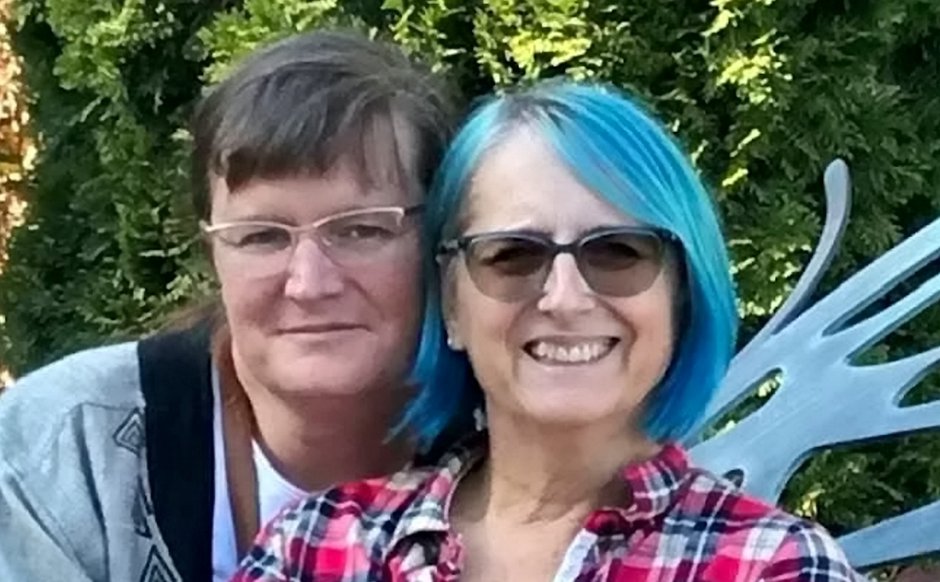 Image by: Katie Papilio
Image by: Katie Papilio
A widower transitioned to become a woman after the death of his wife - and is now set to wed his son's female school teacher.
Joel Stottlemire, 49, found the courage to be the person 'he always knew he was' after his wife of five years, Minxi Liu, 41, died of metastatic breast cancer.
Before her death, Minxi supported his decision and helped her then-husband Joel make the transition to become Katie Papilio.
The couple had one child together, Lucas, aged five, who now knows his 'dad' as Katie - and can't remember her ever being a man.
But amidst the transition and grief, Katie never expected to find love again.
Whilst dropping Lucas at school, she was called over by her son's teacher, Beth Davis, 55, and the pair bonded through sharing stories about grief whilst organising playdates for their kids.
Beth had also been grieving after losing her husband Rhon Davis, 58, to a heart attack - just six months before Katie's wife died.
Within a few months, Katie and Beth became more than just friends as romance blossomed.
They went official with their relationship in August, 2019 - much to Lucas' delight - and got engaged in October 2019.
Katie, an author, from Topeka, Kansas, USA, said: "I wasn't looking for anything, but Beth showed up right when I needed her.
"Losing my wife was so hard - and navigating single parenthood was tricky too - let alone on top of transitioning to become a woman.
"Lucas was amazing throughout - and he was all I needed. I never expected to find love and companionship again.
"When I dropped Lucas at school and picked him up, I'd chat to Beth and we realised how much we had in common.
"Having Beth as a friend and someone to confide in was amazing and I was even more blessed when it progressed into something more.
"Now I can't wait to make her my wife."
Beth, a preschool teacher, said: "Right from when I met Katie, I liked her.
"I used to think she was too cool for me. I'd never dated a woman before and was curious about how I felt for her.
"I desperately wanted to be friends with her, and through organising playdates for our kids, I got there - and further!"
Katie and her first wife, Minxi Liu, married in 2012, when Katie was still a man - and had a son together, Lucas, now five, in May 2014.
The family lived happily together until the shock diagnosis of Minxi's cancer in March 2015.
When Katie confided in Minxi about her wanting to transition, she received the full support of her spouse, despite some initial confusion.
Despite chemotherapy and radiation, Minxi's condition deteriorated, and she passed away in December 2017.
Katie said: "All of a sudden I was a single parent. I was overwhelmed with grief and fear, but thinking about my transition took my mind off things.
"Minxi had known about my feelings regarding my gender. Of course, it was difficult for her to get used to, but when she realised how happy it made me, she let me get on with it.
"I was consumed by the transition, constantly attending appointments, therapy sessions, and being a parent for Lucas, that I didn't have time to think about things properly.
"Minxi's death showed me that life is too short to pretend.
"I loved her so much, and thank her every day for allowing me to consider actually doing what I had always wanted to - to begin my transition and become the person I always knew I was."
 Image by: Katie Papilio
Image by: Katie Papilio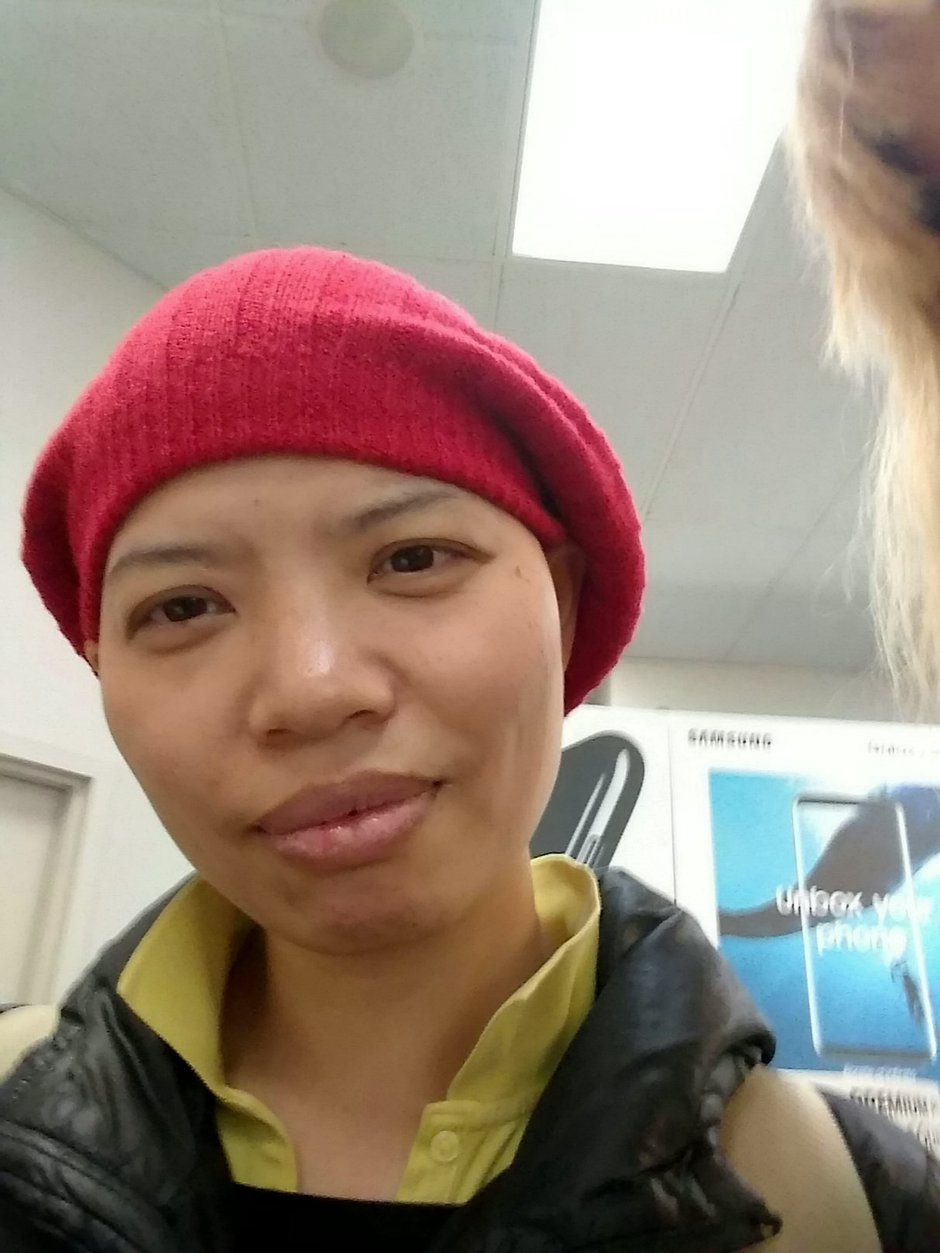 Image by: Katie Papilio
Image by: Katie Papilio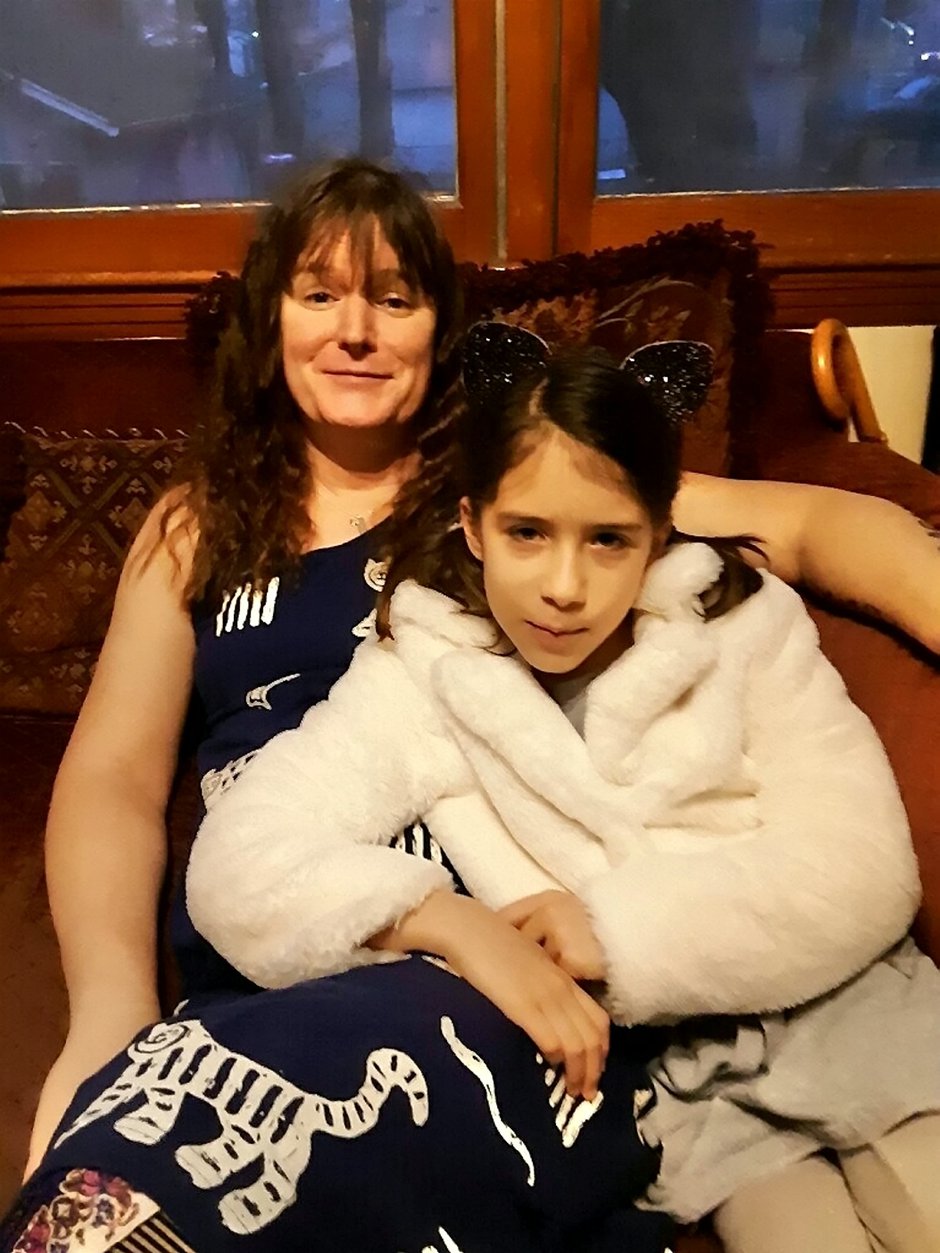 Image by: Katie Papilio
Image by: Katie Papilio
Katie began her transition in June 2016 - undergoing hormone therapy and surgery and completed it in January 2019.
Katie - who does not have contact with the rest of her family - has never told her son Lucas about her previously being male. He has always known her as Katie and can't ever remember her being a man.
In September 2018, when Katie only had a further six months to wait until her gender confirmation surgery, she enrolled Lucas in preschool.
"The first thing I saw when I walked into the school was this amazing flash of bright blue hair," Katie said.
"I thought: 'That looks like my kind of person,' and went over to speak to her.
"She introduced herself as Beth and when I figured out that she was Lucas' new teacher, the thought of seeing her a lot was nice.
"She seemed like the kind of person I would be friends with.
"Her blue hair and tattoos really appealed to me, and I wanted to get to know her, so over the next week we organised a time to take our kids to the park together on a playdate."
Beth was married to her husband Rhon Davis for 31 years until he passed away at 58 years old from a heart attack.
The couple had four children together - Breanne 29, Lauren, 27, Avery, 25, and Aiyana, nine.
Consumed by grief, the mum-of-four threw herself into parenting and teaching.
When Beth met Katie, the topic of loss didn't take long to come up.
Beth said: "We found out pretty quickly that we were both going through the same thing.
"Our spouses died within six months of one another, and to have somebody else around to relate to was a breath of fresh air.
"I thought Katie was too cool for school.
"Never in a million years would I have thought she would be interested in hanging out with me as a friend, let alone become my girlfriend."
During trips to the park and bowling alley, the friends talked about their feelings and discussed Katie's transition at length.
Katie said: "Beth was always there for me, through what was one of the most confusing points of my life.
"We chatted on the sidelines a lot, whilst we watched the kids play, but never got much chance to talk in private.
"I think we both knew something was going on, but neither of us spoke about it."
One night in July 2019, the pair finally managed to have some alone time.
During an evening in, with the kids being looked after by a childminder, the couple decided to watch a documentary entitled 'Out here in Kansas' about being gay in Kansas, Christianity and the troubles that come with homosexuality and religion - which was created by Beth's cousin Adam Knapp, 49.
This led to a serious conversation about Katie's experiences, and brought the two women closer together.
Katie said: "I think neither of us knew where we stood after that night. All I knew was that things were on a different vibe now.
"And then the next morning, Beth texted me something that blew my mind."
Beth's message read: 'Good morning beautiful.'
"She asked me if I could come over, so I went over during my lunch break," Katie said.
When Katie knocked on the front door, she was greeted by a very nervous looking Beth.
Beth said: "I was so incredibly anxious, but I knew I just had to do it.
"I took her face in my hands and kissed her. That's where it all began."
As it was Beth's first same-sex relationship there was lots of questioning, but the couple worked through it and made their relationship official on August 1st 2019.
They went on their first date a month later, taking a trip to Lawrence, Kansas, where they ate at a Greek restaurant and strolled hand-in-hand.
With their relationship official and the future looking bright, the couple knew that the time had come when they would have to reveal it to their children.
Katie said: "Telling Lucas was easy. I got myself all nervous, but as he was just five years old, he just accepted it.
"I just explained that Beth and I were really good friends, and now we were going to be a bit more than that - he was completely fine with it!"
Due to her children being older, telling them about her relationship with Katie was something Beth was afraid of.
"When I told Breanne, I had got myself all nervous and worked up," Beth explained.
"But she just said: 'Yeah, we already know that mum!' it was a huge relief!"
Since the couple becoming partners, they have bought a new house in Topeka together, where they will live with Aiyana and Lucas.
In October 2019, Katie needed to buy a new car, due to her brakes not working. Whilst looking for a new car, the couple realised that they may as well buy one together.
Katie said: "I don't know why, but this just confirmed things for me. Buying a car together is a big, long-term commitment. And the fact that we were both so happy to do that just proved it to us.
"When we were driving home, I looked at Beth and told her I didn't want to be her girlfriend anymore."
Beth said: "Hearing that was incredible. I told her I didn't want to be her girlfriend either.
"I wanted to be her wife."
The couple bought matching engagement rings and have set the date for their wedding in June 2020.
"I never thought I could feel this comfortable in my life and in myself," Katie said.
"When Minxi passed away, I thought that was the end of everything for me.
"I have found myself, but I have also found love."
London's latest kebab restaurant has opened - on board a double decker bus
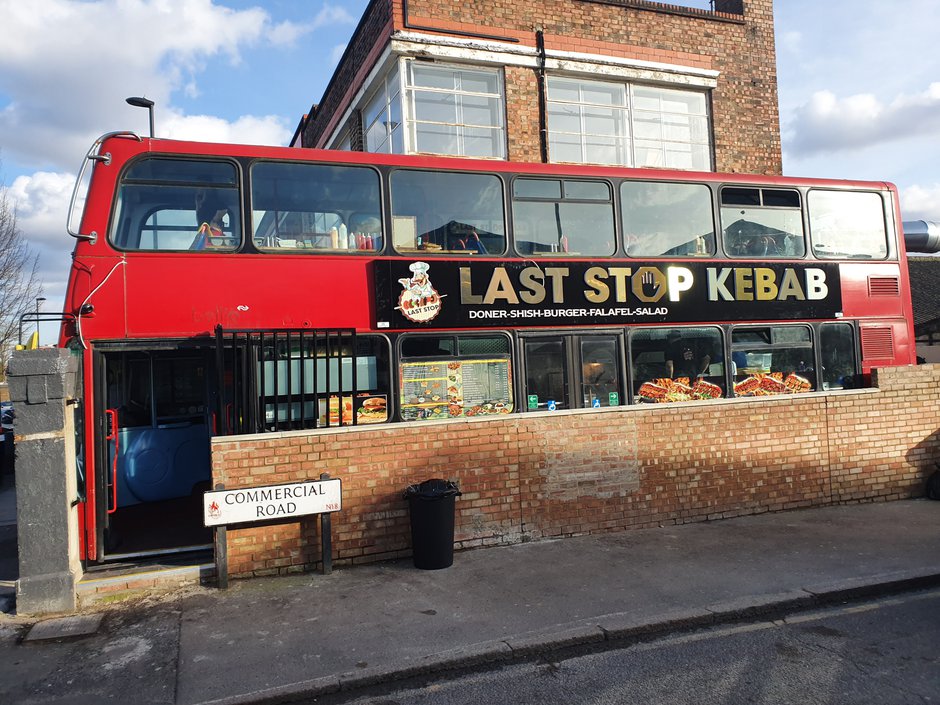 Image by: Steve Chatterley
Image by: Steve Chatterley
London's latest kebab restaurant has opened - on a double decker bus.
Tucking into a doner on board a London bus normally brings groans from fellow passengers, but it's positively encouraged at Last Stop Kebab in Edmonton, north London.
The bus themed Turkish restaurant can seat 40 customers at a time, and the on board experience includes the original TfL moquette designs on the seats.
There were only 20 days between when ambitious owner Firat Amara first thought of the idea to renovate a former Tansport for London double-decker bus and when he bought it on December 20.
From there it was hard work to transform it into a place fit for dining and it took two months to get everything ready.
Firat and two colleagues had to remove some seats, remove the engine and the back tyres to allow space for tables, chairs, a kitchen and the all-important doner kebab machine.
The gas, electricity and water needed to run the business comes from the supermarket Fnext door that Firat part-owns.
The 41-year-old was very coy about the bus he bought in London and did not want to reveal how much he had paid for it.
“That’s a secret,” he chuckled.
“It cost me a lot of money but I don’t want to say how much I spent on it.
“I thought, everything is running on social media.
“If I get a double decker bus then people will share it on Instagram, be interested to come and will use it as an advert.”
He was not wrong, so far videos of the creative concept have been liked more than 450,000 times on social media and people are travelling from all over London to experience the service themselves.
Firat said: “That’s what we wanted and that’s what we want and deserve.
“All day we’ve been busy and haven’t been stopped, I hope that carries on.
“We are so happy because we did something and people are giving good appreciation.”
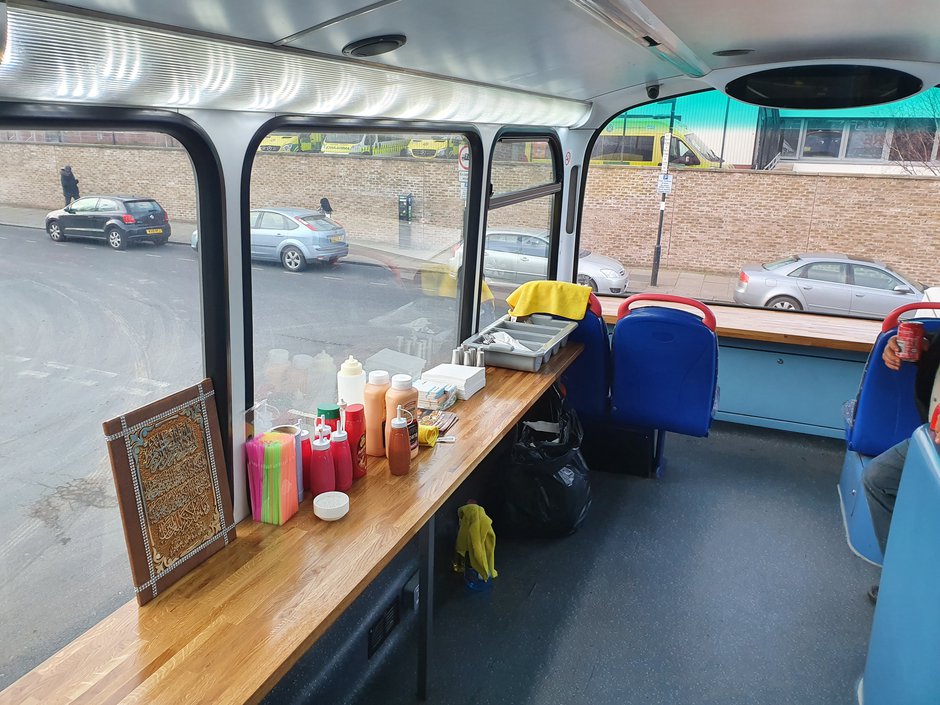 Image by: Steve Chatterley
Image by: Steve Chatterley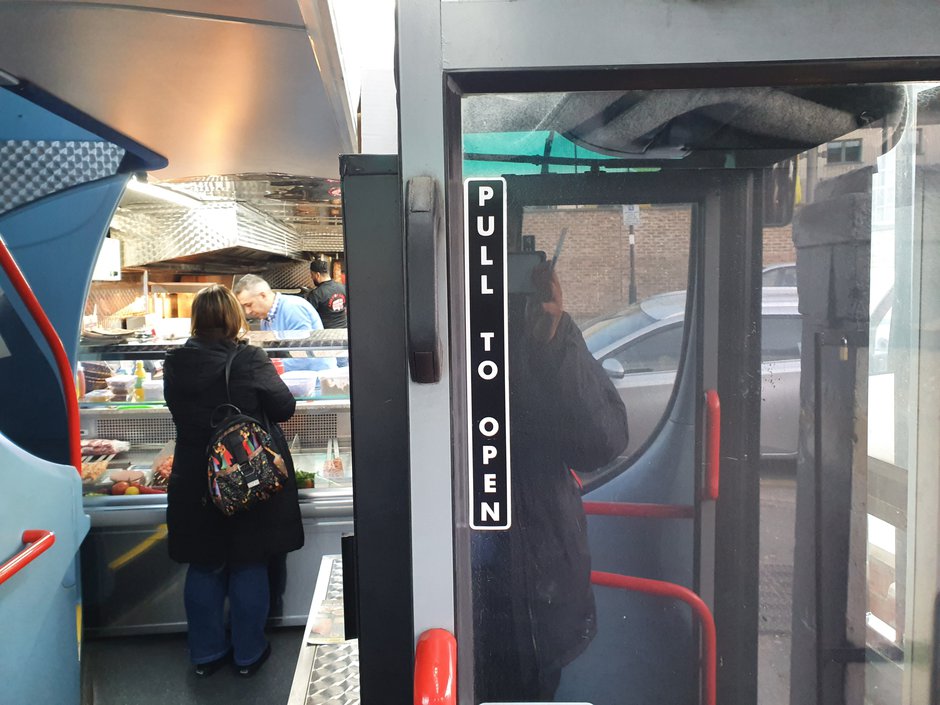 Image by: Steve Chatterley
Image by: Steve Chatterley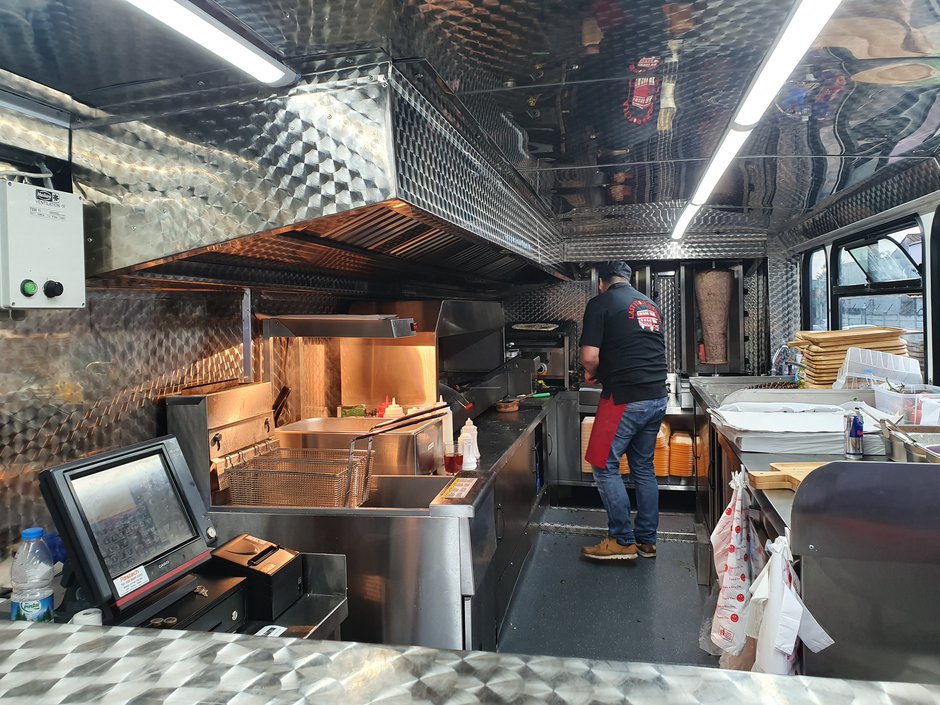 Image by: Steve Chatterley
Image by: Steve Chatterley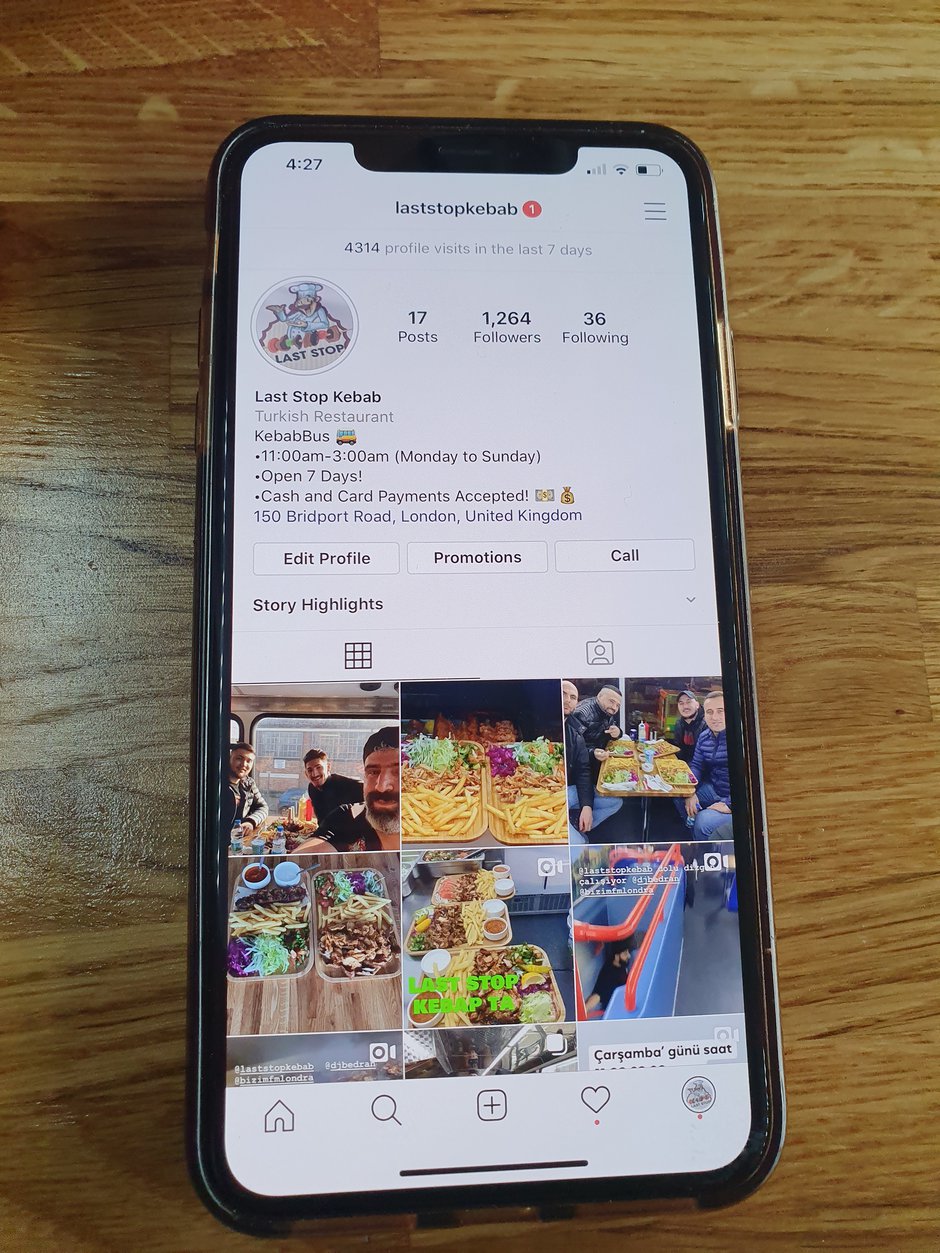 Image by: Steve Chatterley
Image by: Steve Chatterley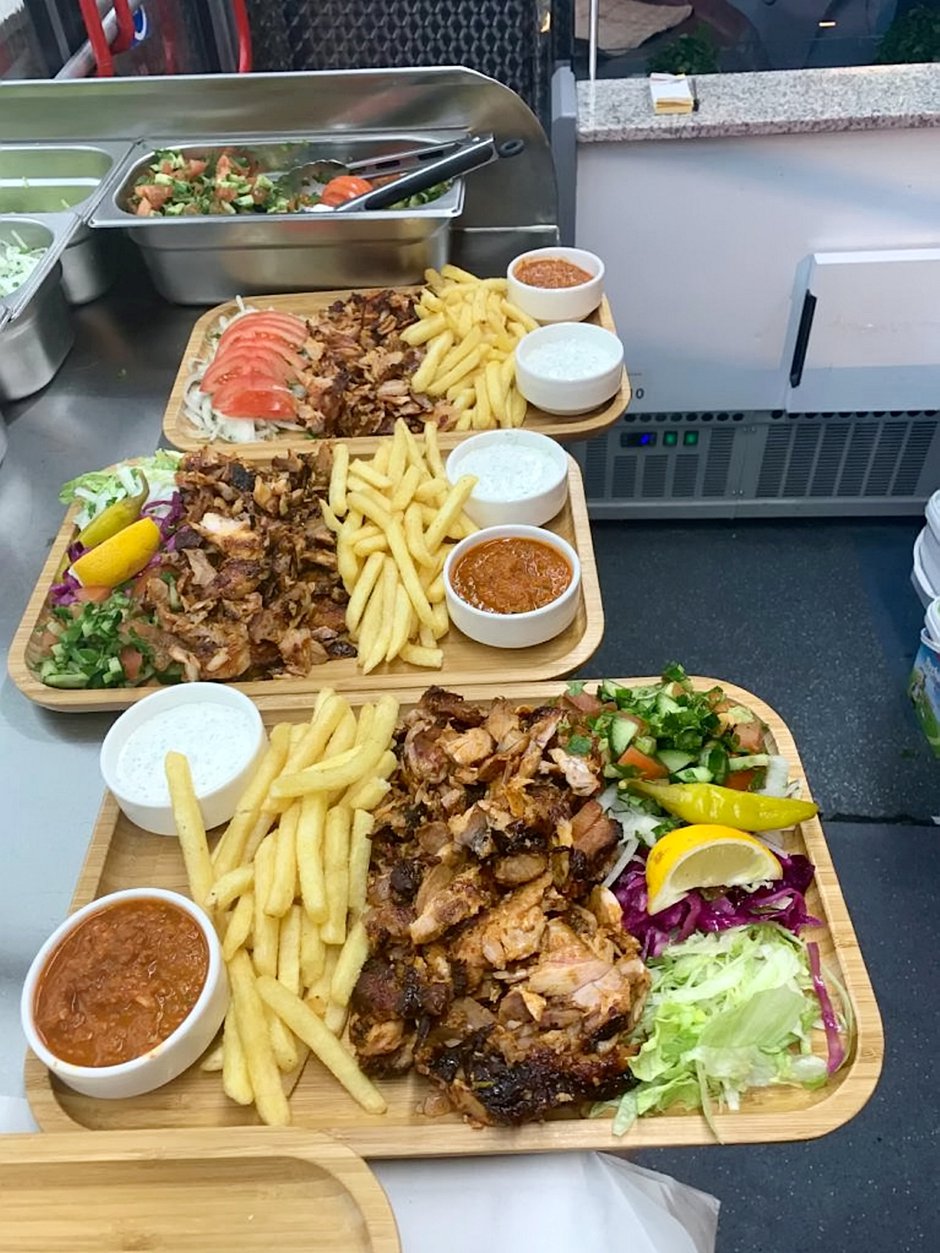 Image by: Steve Chatterley
Image by: Steve Chatterley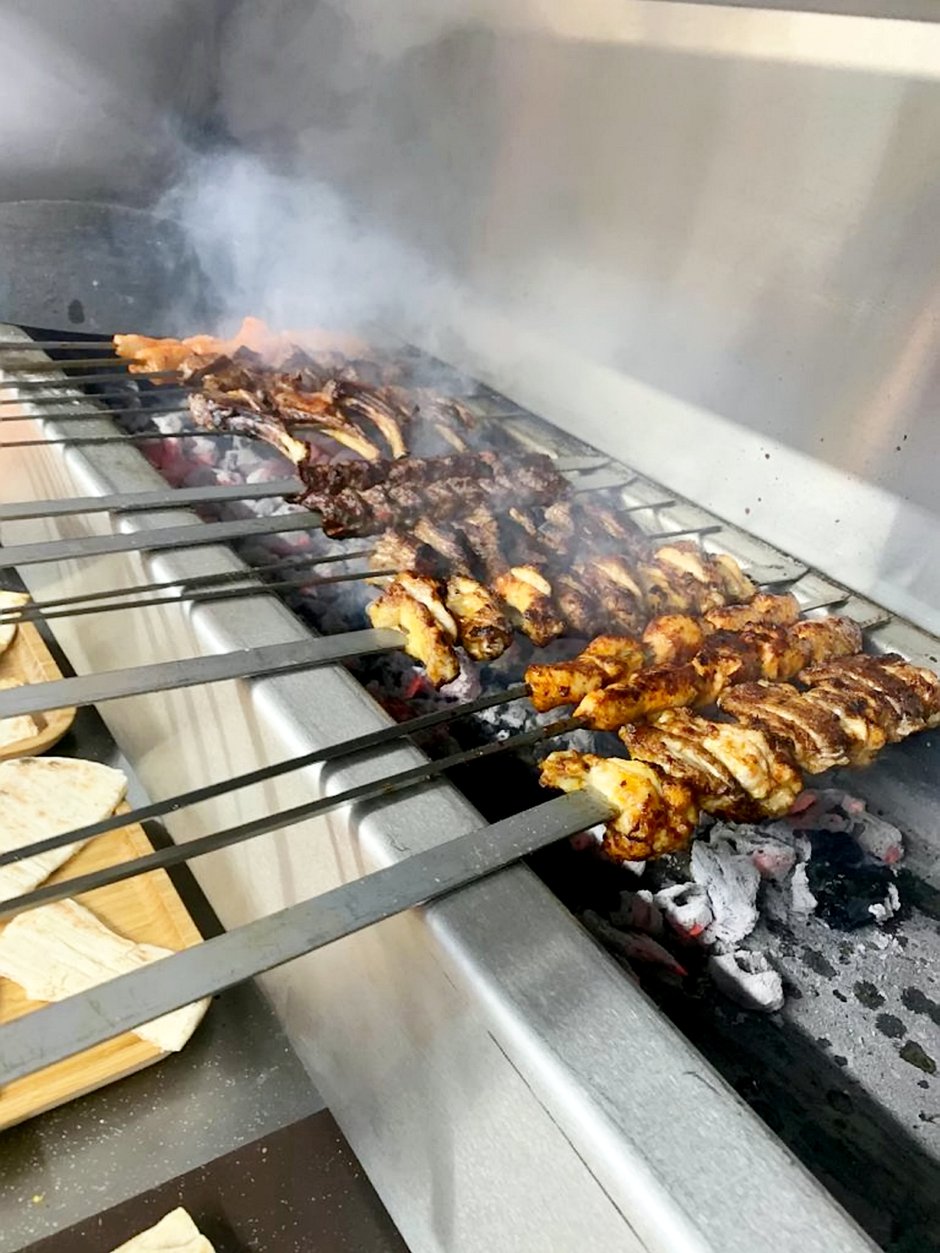 Image by: Steve Chatterley
Image by: Steve Chatterley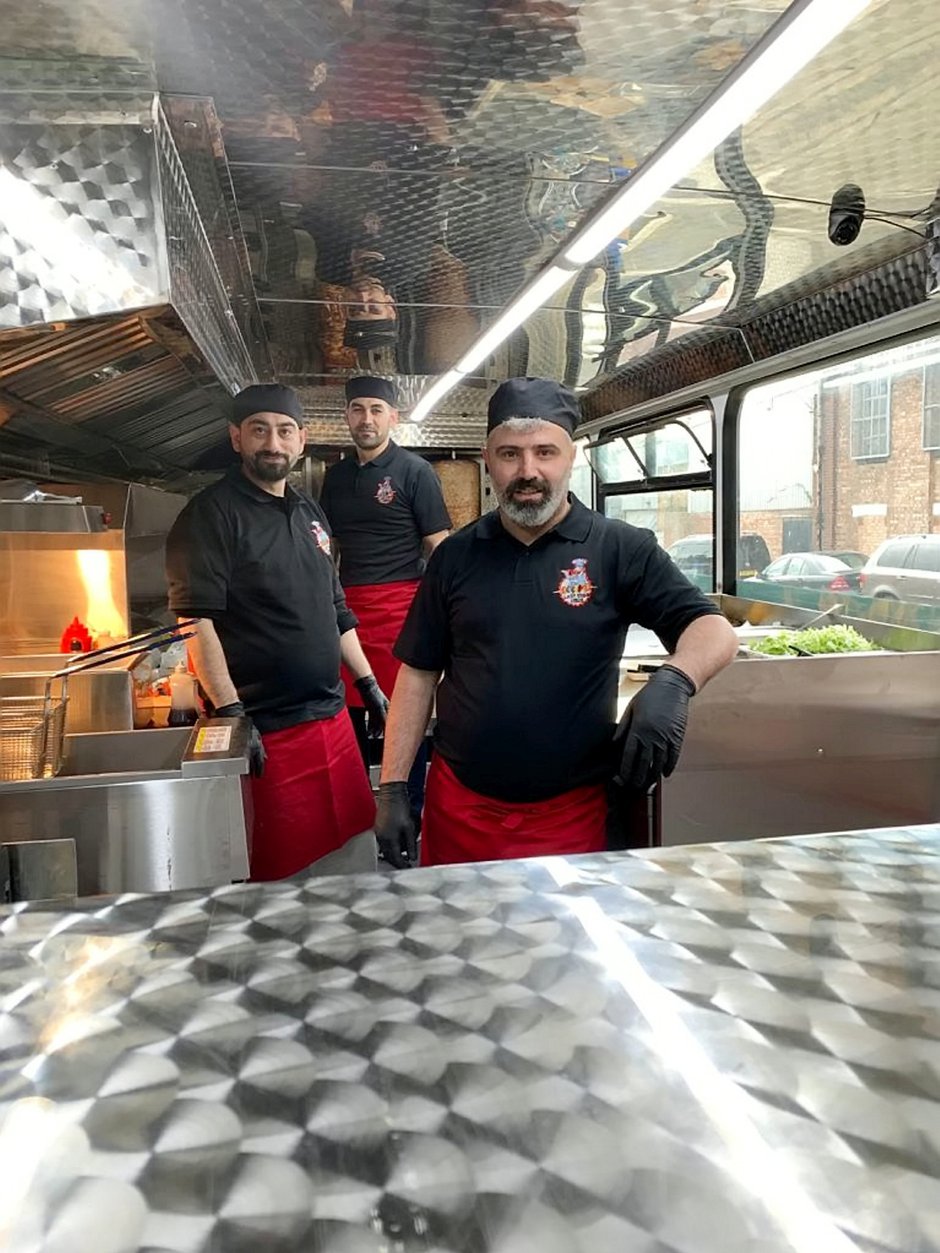 Image by: Steve Chatterley
Image by: Steve Chatterley
Since opening, Last Stop Kebab has been very busy with the upstairs packed, the downstairs full and queues of people outside of the door.
There is only space for three members of staff in the tiny, yet packed kitchen of the operation.
Customers should not worry about entertainment as there is Turkish music blasting through the bus’s original tannoy system as they tuck-in.
However, despite all its perks, like on all London buses, there is no toilet on-board.
There were a lot of people in the Edmonton area asking for hot food, both residents and visitors and employees of North Middlesex hospital because the nearest restaurant is a 20-minute walk away.
Firat was determined to think outside of the box and use his 25 years’ kebab experience to start something revolutionary.
He said: “I was always going to do it because at the end of the day what you put in is what you get back.
“You get the fruits from the tree, now it’s the sweet time and we are enjoying the customers.
“I love risk because when you do business, it’s a risky job, if you put in risk you get the money.
“So far, it’s working very well, I’m so happy and they make me so excited each time.”
The kebab bus serves a combination of kebabs, fresh salads and delicious wraps to customers every day from 11am to 3am.
One friend of Firat told him to scrap his entire plan before it even started and has been surprised at how successful it has been.
Firat added: “It wasn’t a surprise to me I knew it woyld happen.
“I asked my customers everyone said to go ahead with it, and they asked me every day when is it going to be open?”
The entrepreneur is already thinking about buying more buses and expanding to central London and Stratford in east London to tap in to different markets.
Video by: Gabriella Petty
WHO WALKS TO BE A MILLIONAIRE? - WW2 veteran walking 100 lengths of back garden before 100th birthday has raised over £1million for NHS in just one week
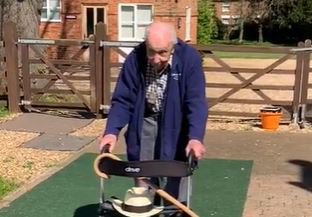 Image by: Simon Galloway
Image by: Simon Galloway
A World War Two veteran who is walking 100 lengths of his back garden before his 100th birthday has raised over a MILLION pounds for the NHS in just one WEEK.
Tom Moore, 99, says the NHS have been "marvellous" in helping him recover from both a hip replacement, and skin cancer on his head, over the last couple of years.
As a way of saying thank you, the former civil engineer has been doing daily laps of his 25-metre long garden, with the aim of walking 100 lengths - or 2,500 metres - by his 100th birthday on April 30.
Tom, who began his walks last Monday (April 6), initially set a fundraising target of £1,000 for NHS Charities Together, only expecting support from his village of Marston Moretaine, Beds.
But after hitting headlines last week, Tom quickly smashed through his target - and has now raised over £1.3million for frontline health workers.
He told the BBC: "I thank the British public from the bottom of my heart.
"Who would have thought that when I set a target of £1,000 a week ago, it could have reached £800,000?"
Tom added: "It's difficult to imagine all these kind people who have donated so far. It's just amazing."
Tom's daughter, Hannah Ingram-Moore, who set up the fundraising page for him, has had to raise his target three times - from £1,000 to £100,000, then to £250,000 and £500,000.
She took to Twitter to say: "We are overwhelmed by the response. It's extraordinary. We remain proud and humbled by the generosity of the British public."
Tom was born and raised in Keighley, Yorkshire, where he went to grammar school and later went on to complete an apprenticeship as a Civil Engineer.
He was then enlisted in 145 Regiment Royal Armoured Corps at the beginning of the war, and in 1940 was selected for Officer Training.
After completion, Captain Tom Moore went on to be posted in the 9 DWR in India and served and fought on the Arakan and Burma.
After all overseas duties were said and done, Tom returned to the UK to become an Instructor at The Armoured Fighting Vehicle School in Bovington, Dorset.
To support Tom's walk, visit: https://www.justgiving.com/fundraising/tomswalkforthenhs.
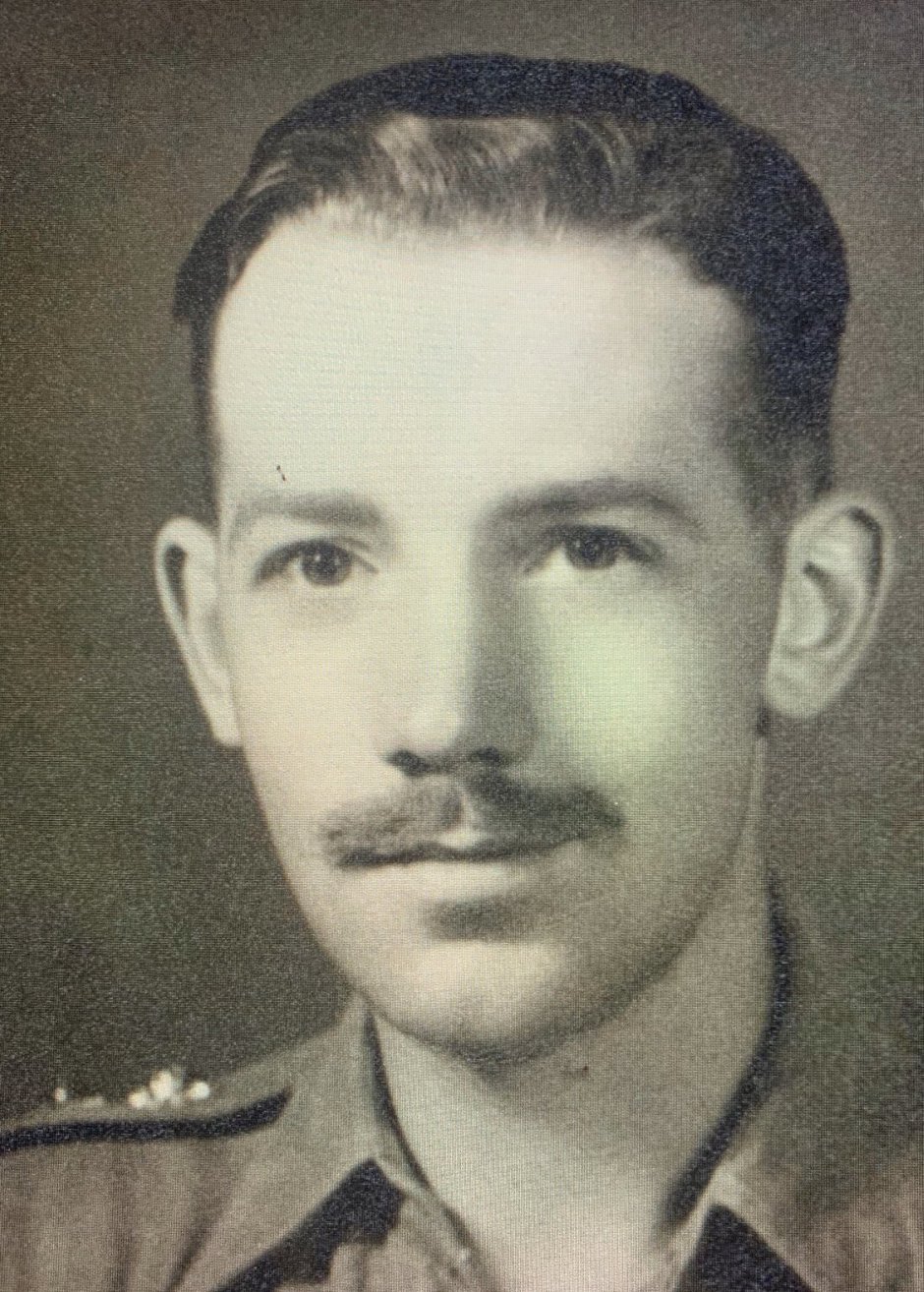 Image by: Simon Galloway
Image by: Simon Galloway
Tom, whose total now stands at over £1.5million as of Tuesday lunchtime, took to Twitter this morning to write: "Wow, over one million pounds for our beloved NHS!
"I may be walking in my garden to raise money, but this is the British public’s contribution. You are all wonderful - and make Great Britain - GREAT.
"Thanks to everyone - we stand united even during the most testing of times."
And his daughter, Hannah, added: "£1.5 million - we are speechless, celebrating the news.
"Thank you - and a huge thank you to our NHS at this terribly sad time in the country. We are behind you every step."
Video by: Hannah Ingram-Moore
Hero Tom Moore was left speechless at the end of yesterday (Tues) as his fundraising total tipped over the £2million mark.
Having started the day on £850,000, he managed to raise more than £1.3 million in just seven hours.
With his fundraising total standing at £2.2 million by 4pm on Tuesday, Tom posted on Twitter: "2 MILLION POUNDS!
"When I started this journey last Monday, my target was £1,000 for our incredible NHS.
"Since this morning, we have raised another £1.3 million pounds.
"No words left... just thank you."
And in a subsequent Tweet, he added: "Over 100,000 of you have donated to the NHS - I salute you all.
"Thanks for joining me on this mission for our heroes at this very challenging and saddening time in the world. We stand united."
To support Tom's fundraising efforts, visit: https://www.justgiving.com/fundraising/tomswalkforthenhs
Video by: Gabriella Petty


